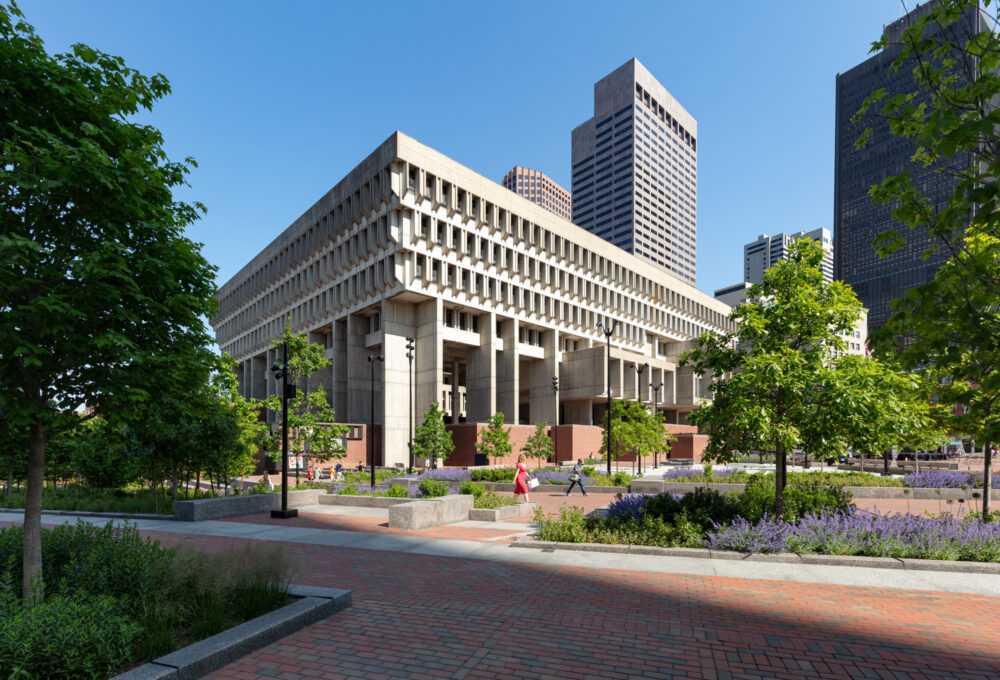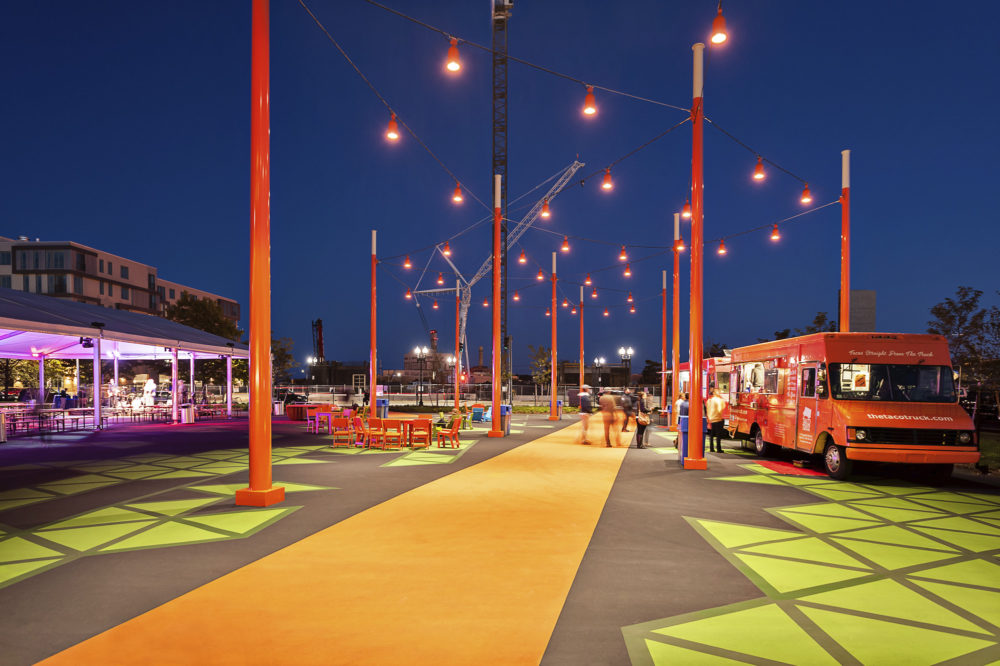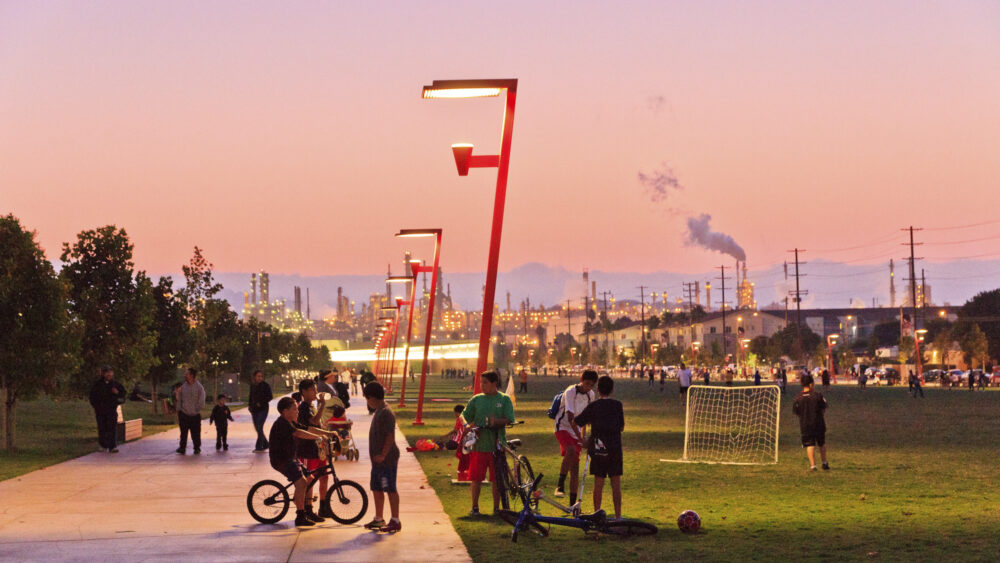Recasting an industrial and underutilized waterfront into a bustling urban destination through a feat of design and engineering
Chicago Riverwalk
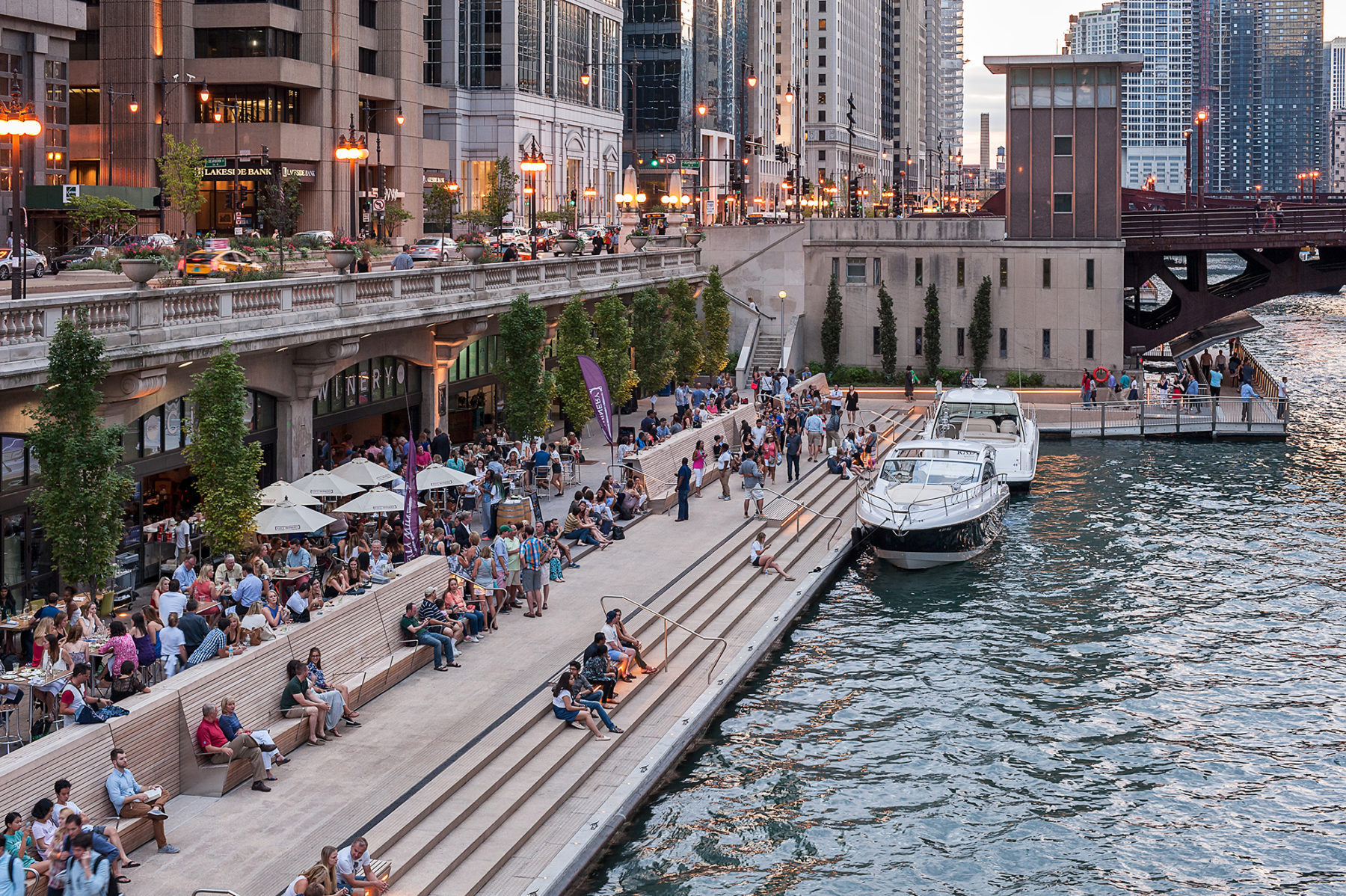
The final phases of an ambitious initiative to reclaim the Chicago River for the ecological, recreational, and economic benefit of the city, the Chicago Riverwalk project offers unity and diversity
The Main Branch of the Chicago River has a long and storied history that in many ways mirrors the development of Chicago itself. Once a meandering marshy stream, the river first became an engineered channel to support the industrial transformation of the city. Following the famed reversal of the river, in which the city reversed the flow of the Main Branch and South Branch to improve sanitation, architect and urban planner Daniel Burnham introduced a new civic vision of riverside promenades with the addition of the Wacker Drive viaduct. Over the last decade, the role of the river has been evolving with the Chicago Riverwalk project—an initiative to reclaim the Chicago River for the ecological, recreational and economic benefit of the city.
The goal of embracing the river as a recreational amenity seemed impossible years ago given the river’s high levels of pollution. But today that vision is becoming a reality. Recent improvements in river water quality and the increased intensity of public recreational use signal growing life along the river, demanding new connections to the water’s edge. Heeding this call, the Chicago Department of Transportation led the construction of the Chicago Riverwalk, completing portions of the system that include very successful new spaces like the Veteran’s Memorial Plaza and Wabash Plaza.
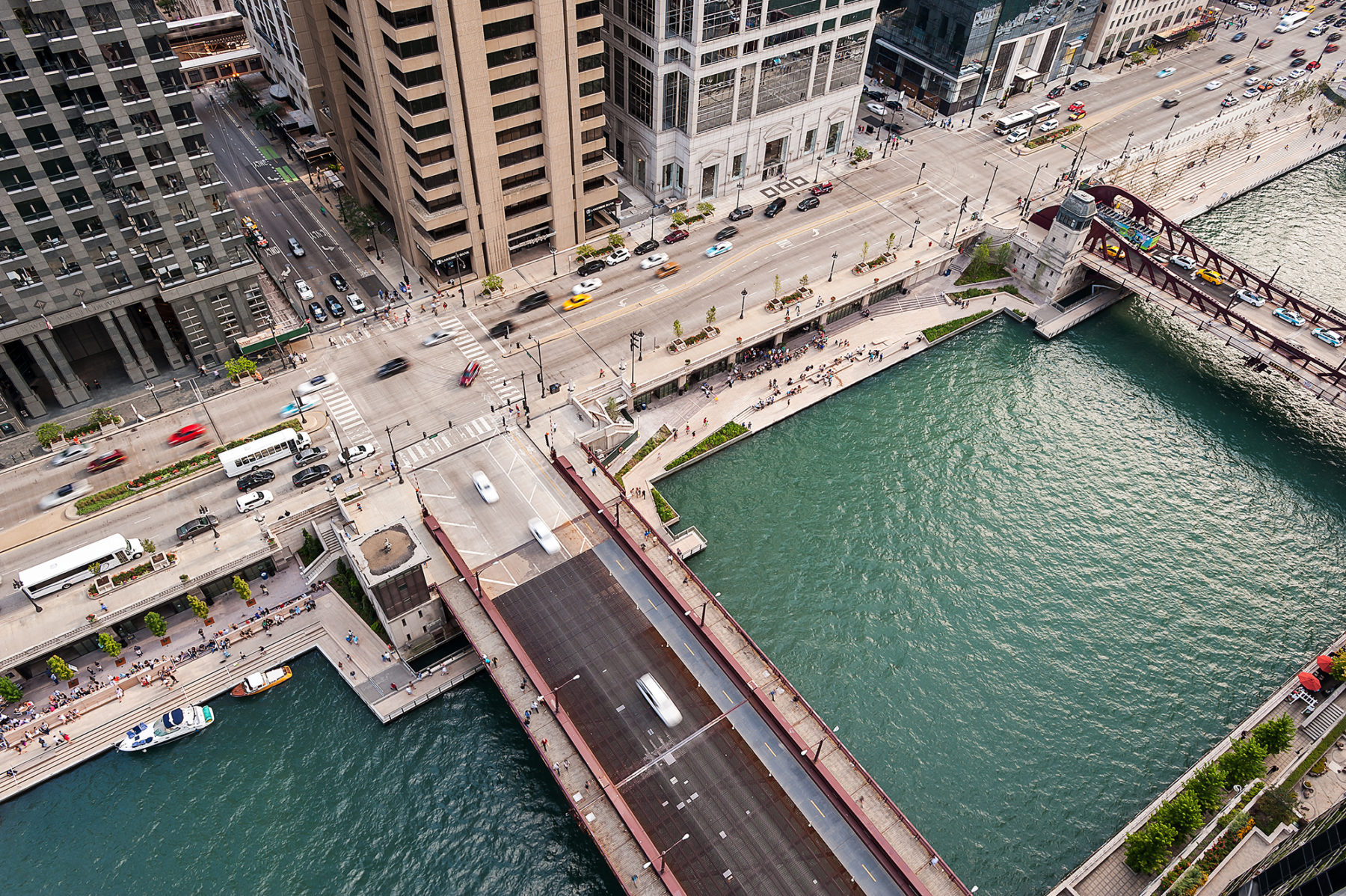
A new model for realizing a significant capital improvement project, the Riverwalk was funded by a federal transportation grant which will be repaid with revenues from the project
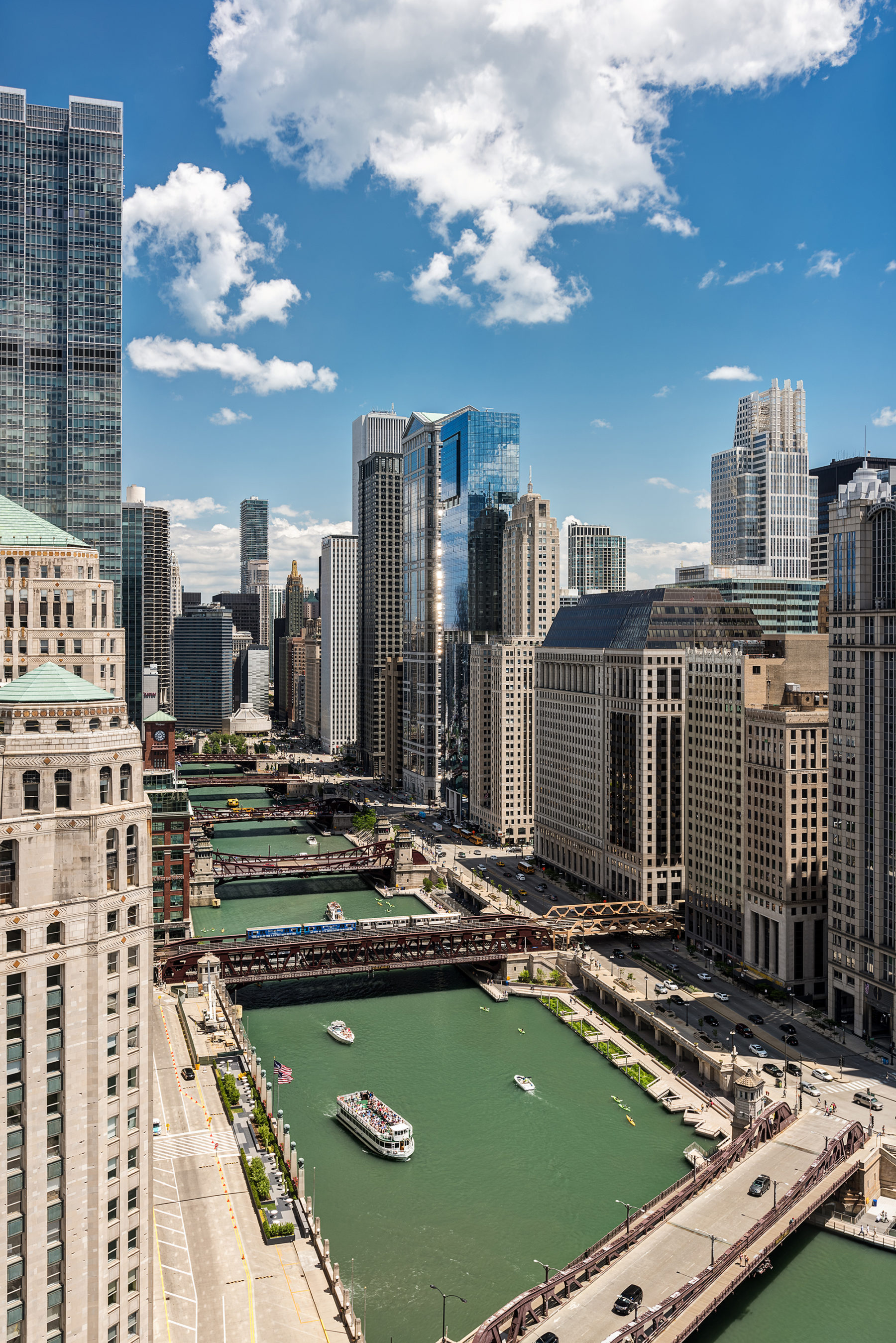
The design team worked within a tight permit-mandated 25-foot-wide build-out area and a technically complex context to expand the pedestrian program spaces and negotiate a series of underbridge connections between blocks
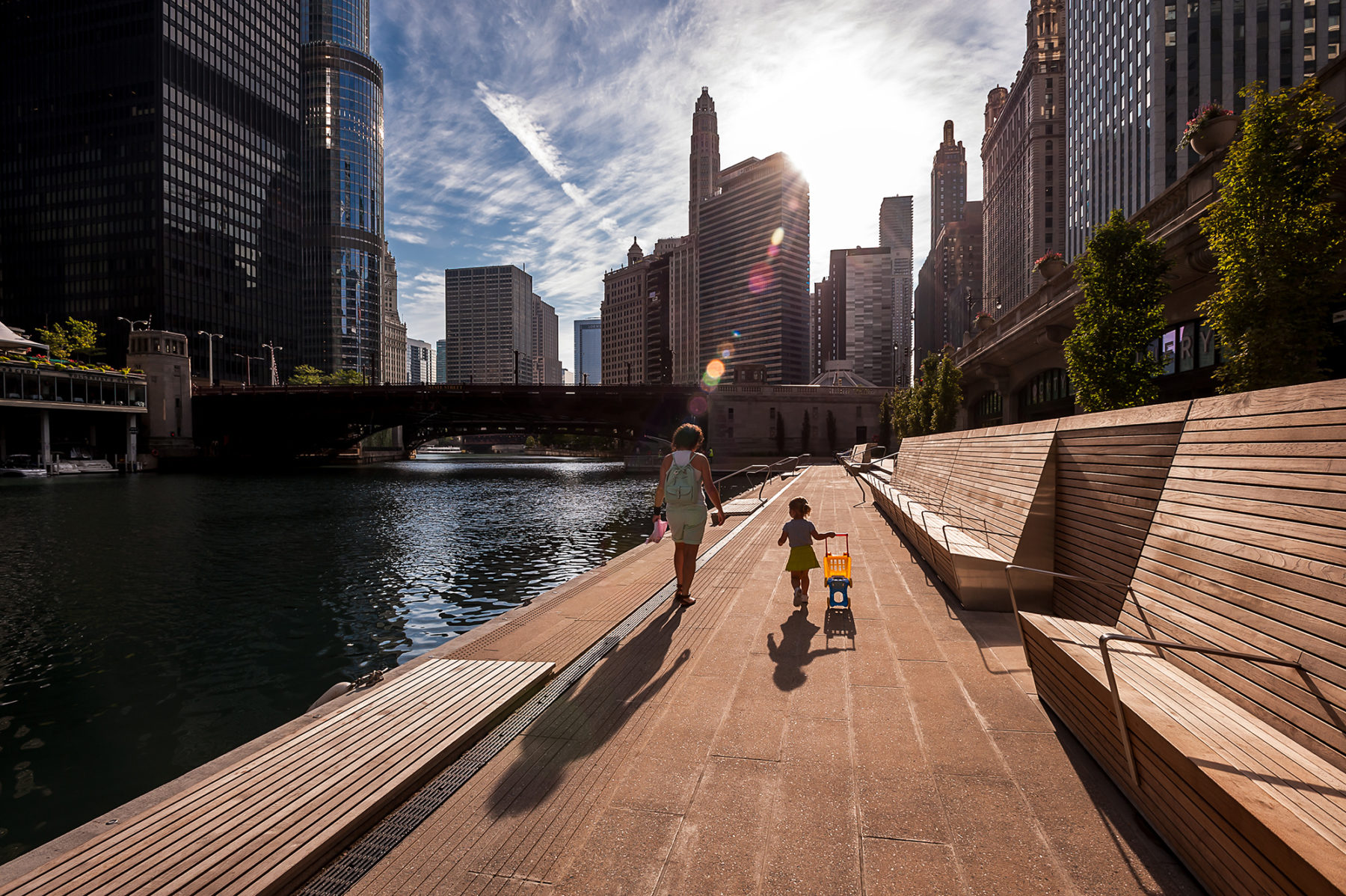
Before the city comes to life, the generous Riverwalk is a peaceful respite from the hustle and bustle of downtown activity
In 2012, Sasaki, Ross Barney Architects, Alfred Benesch Engineers, Jacobs/Ryan Associates, and a broader technical consultant team, was tasked with creating a vision for the six blocks between State Street and Lake Street. Building off the previous studies of the river, the team’s plans provide a pedestrian connection along the river between the lake and the river’s confluence.
The task at hand was technically challenging. The design team, for instance, needed to work within a tight permit-mandated 25-foot-wide build-out area to expand the pedestrian program spaces and negotiate a series of under-bridge connections between blocks. Further, the design had to account for the river’s annual flood dynamics of nearly seven vertical feet.
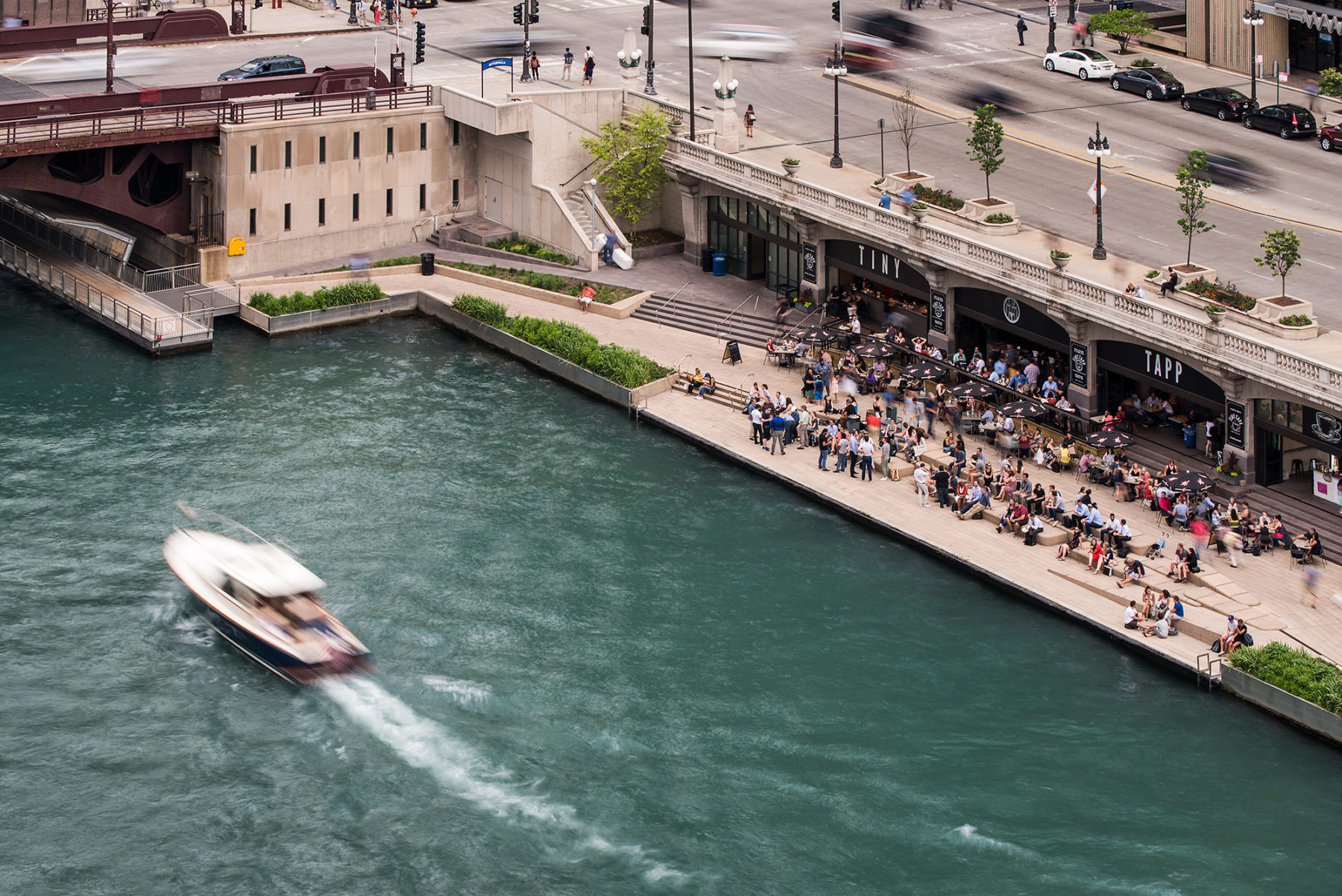
Located between Dearborn and Clark Streets, the Cove, was inspired by beach landscapes
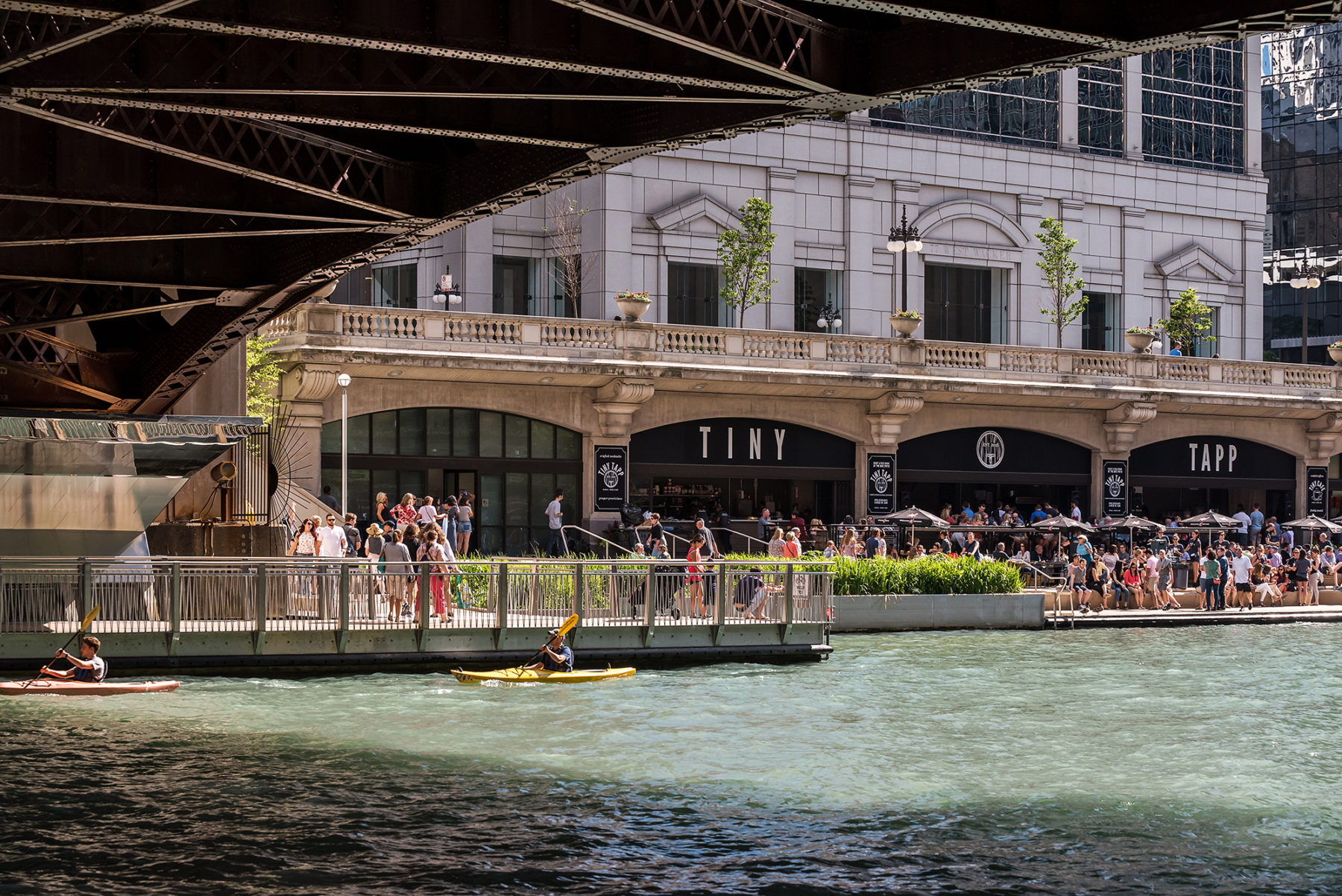
The 100 million dollar budget, made possible by federal loan, will be paid back through developed retail and has spurred eight billion dollars in local area investment. With both phases open in Fall 2016, the immediate overwhelming success of the project is transformative for Chicago.
Turning these challenges into opportunities, the team imagined new ways of thinking about this linear park. Rather than a path composed of 90-degree turns, the team reconceived of the path as a more independent system—one that, through changes in its shape and form, would drive a series of new programmatic connections to the river.
With new connections that enrich and diversify life along the river, each block takes on the form and program of a different river-based typology. These spaces include:
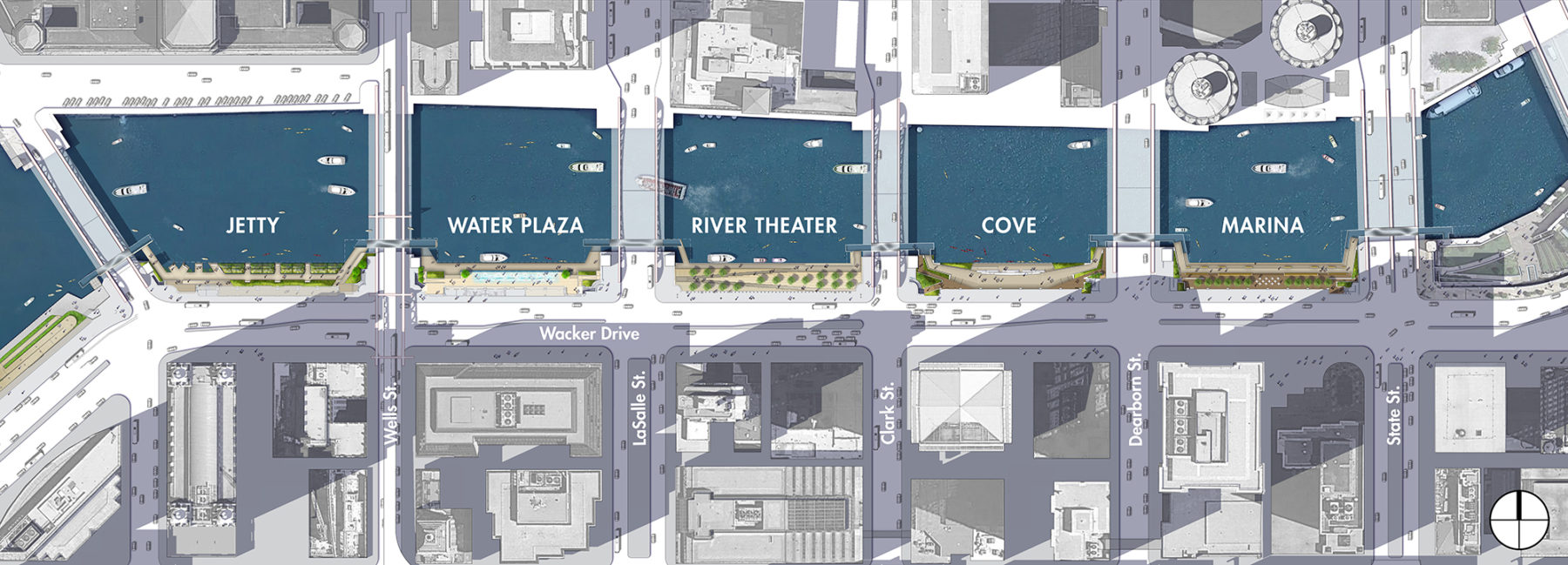
With new connections that enrich and diversify life along the river, each block takes on the form and program of a different river-based typology
The Marina Plaza
Restaurants and outdoor seating provide views of vibrant life on the water, including passing barges, patrols, water taxis, and sightseeing boats.
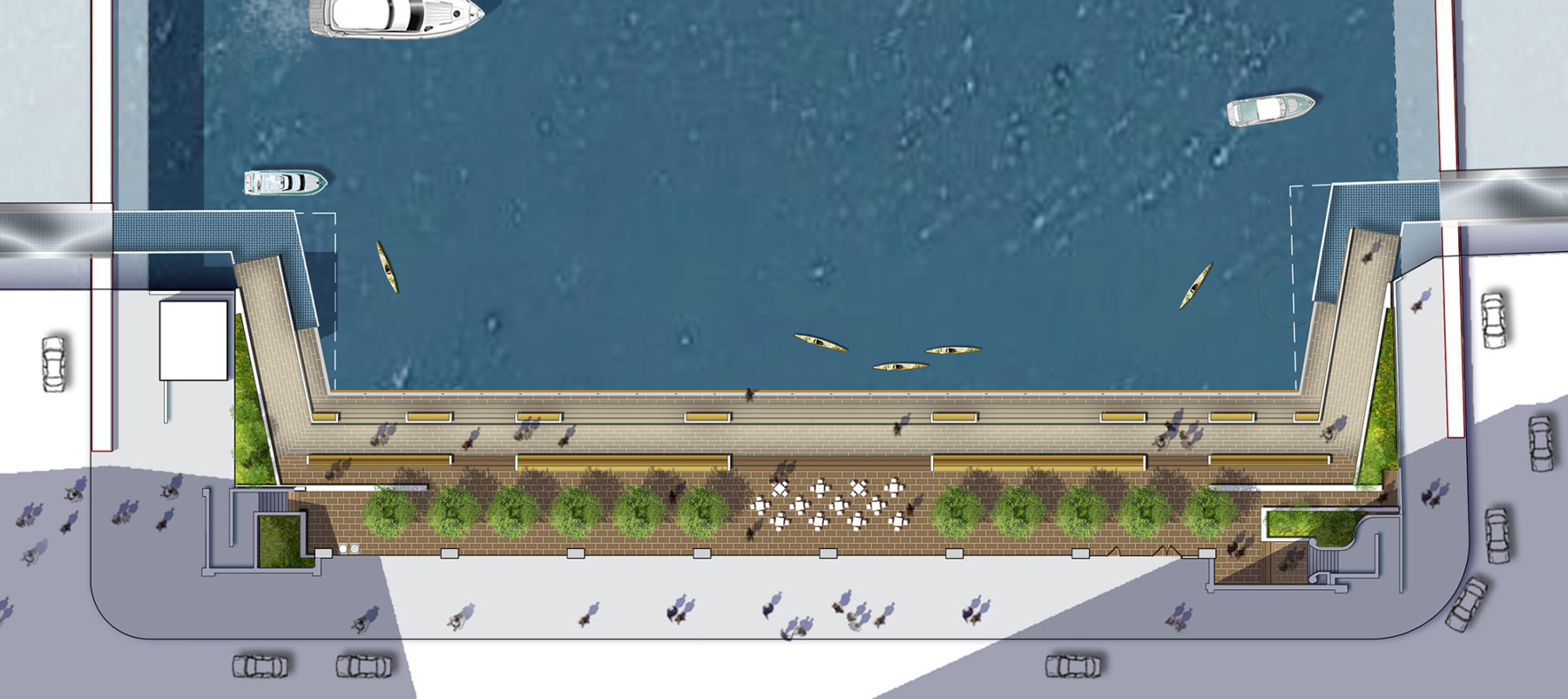
The Marina Plaza
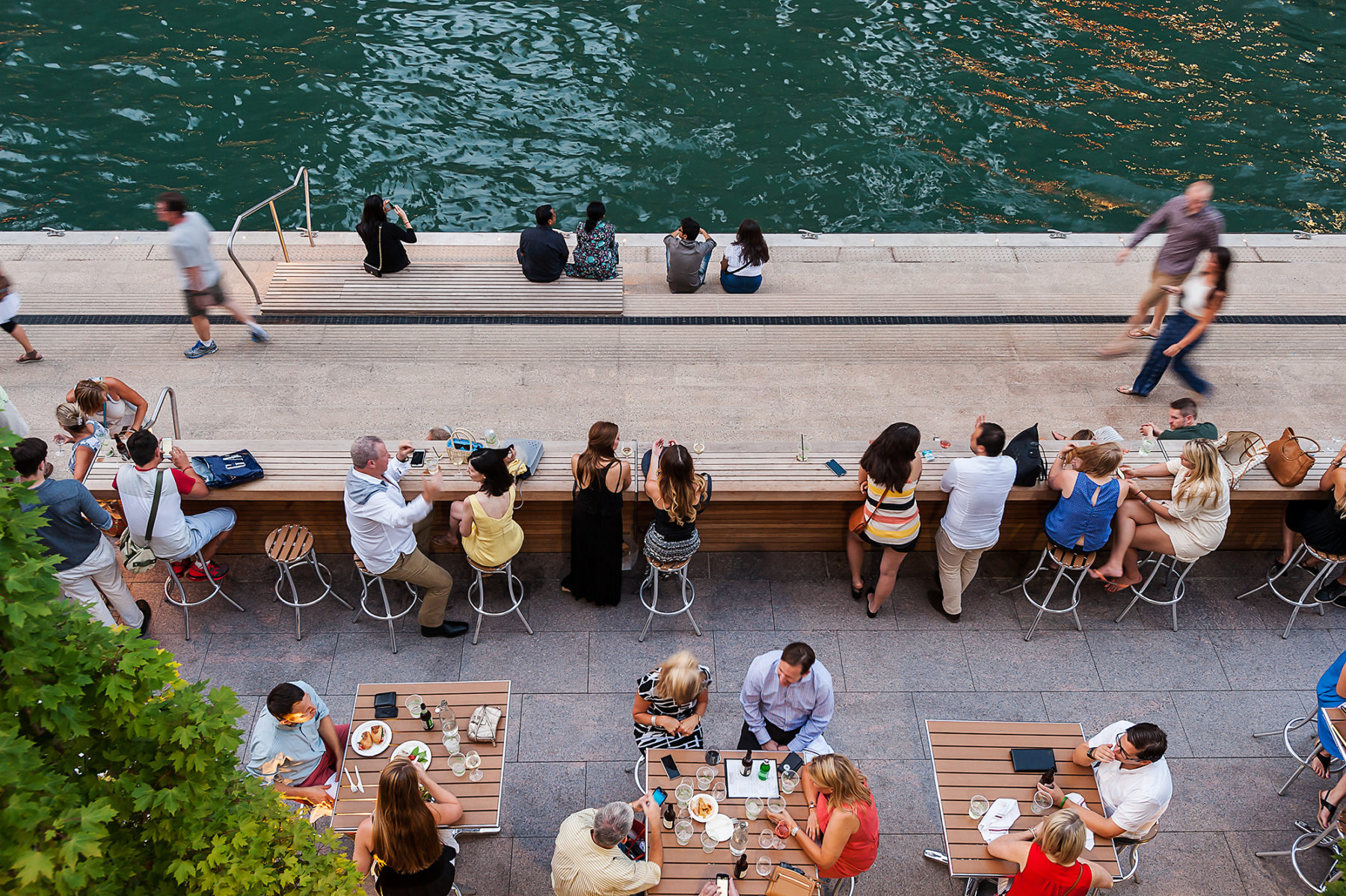
A new model for realizing a significant capital improvement project, the Riverwalk was funded by a federal transportation grant which will be repaid with revenues from the project
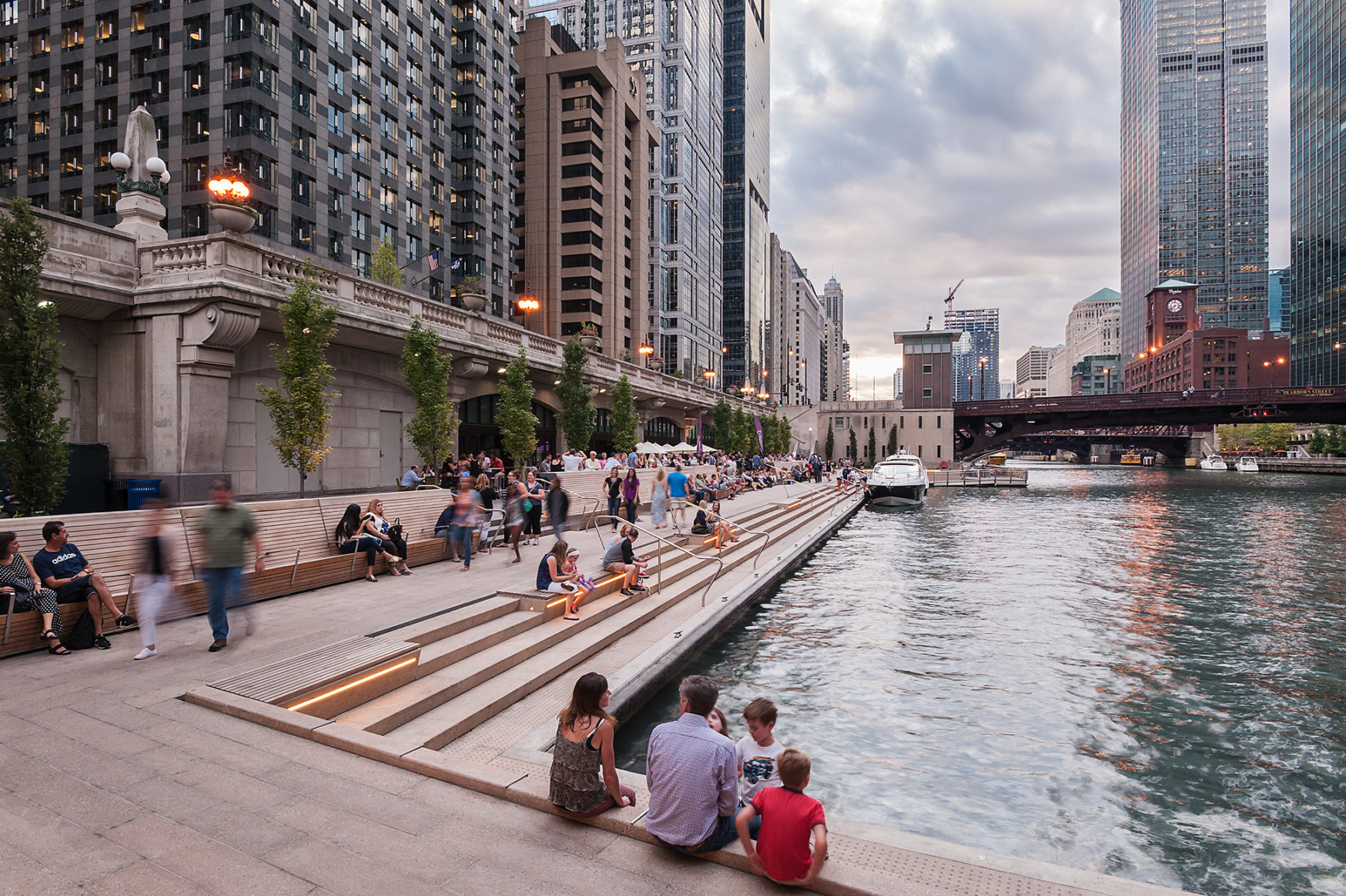
Steps descend to nearly river level in the Marina Plaza providing users direct connection to the water
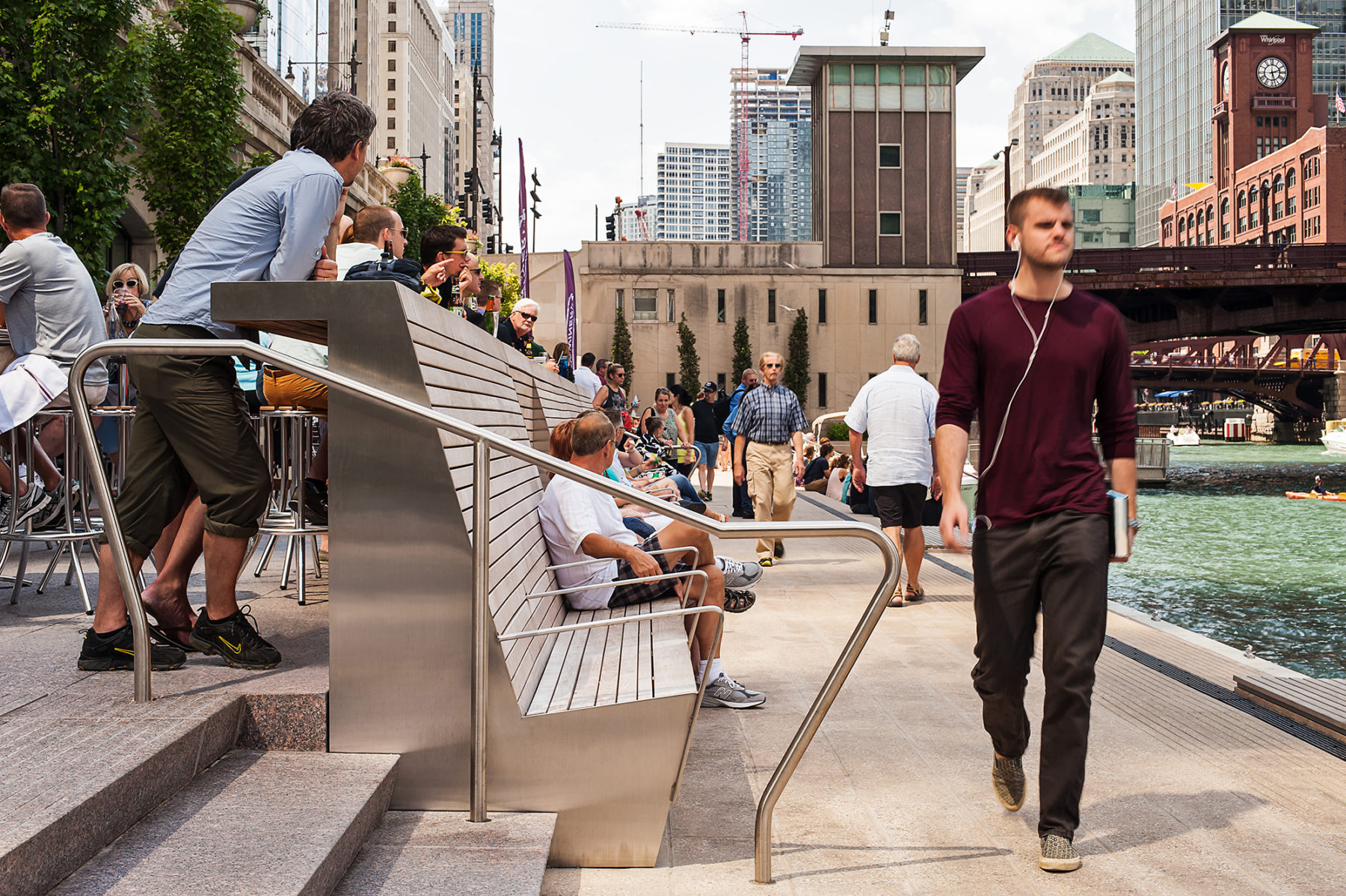
Restaurants and outdoor seating provide views of vibrant life on the water, including passing barges, patrols, water taxis, and sightseeing boats
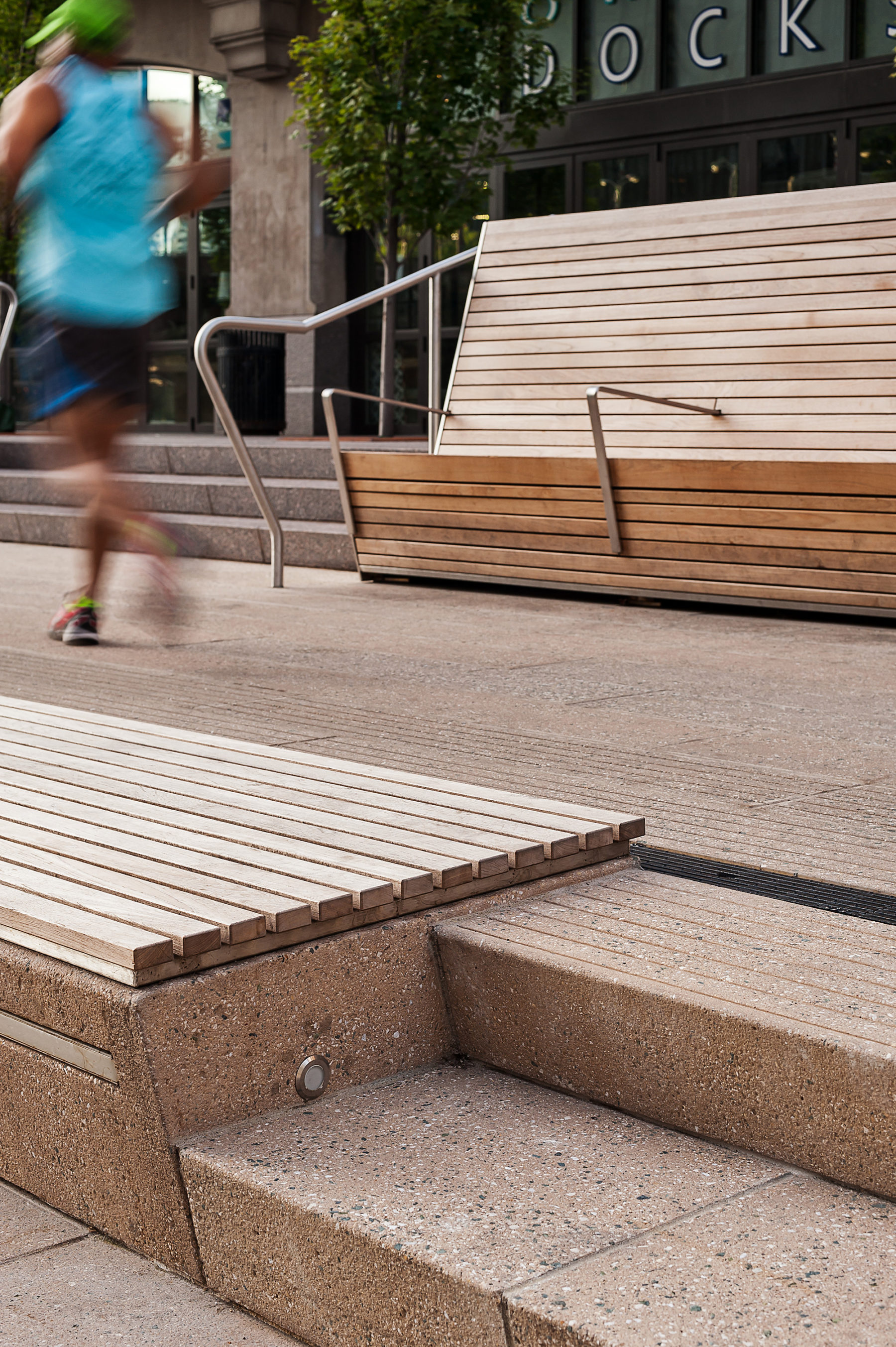
Elegantly-detailed and custom high-backed teak benches provide great place to sit and watch life on the river and create a dramatic edge to the new Riverwalk walkway
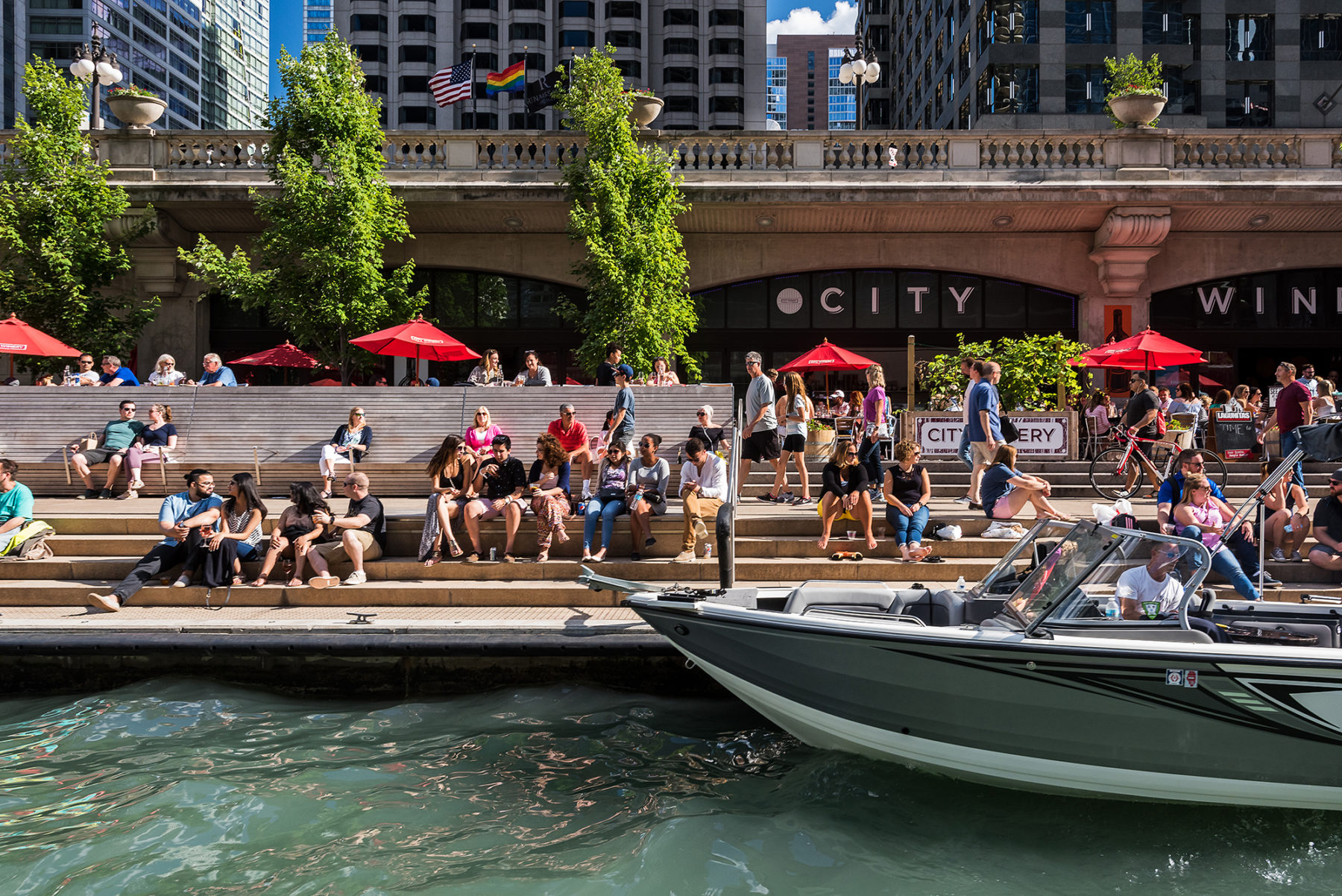
Since it’s opening, the Riverwalk has become a beloved destination by Chicagoans and visitors alike
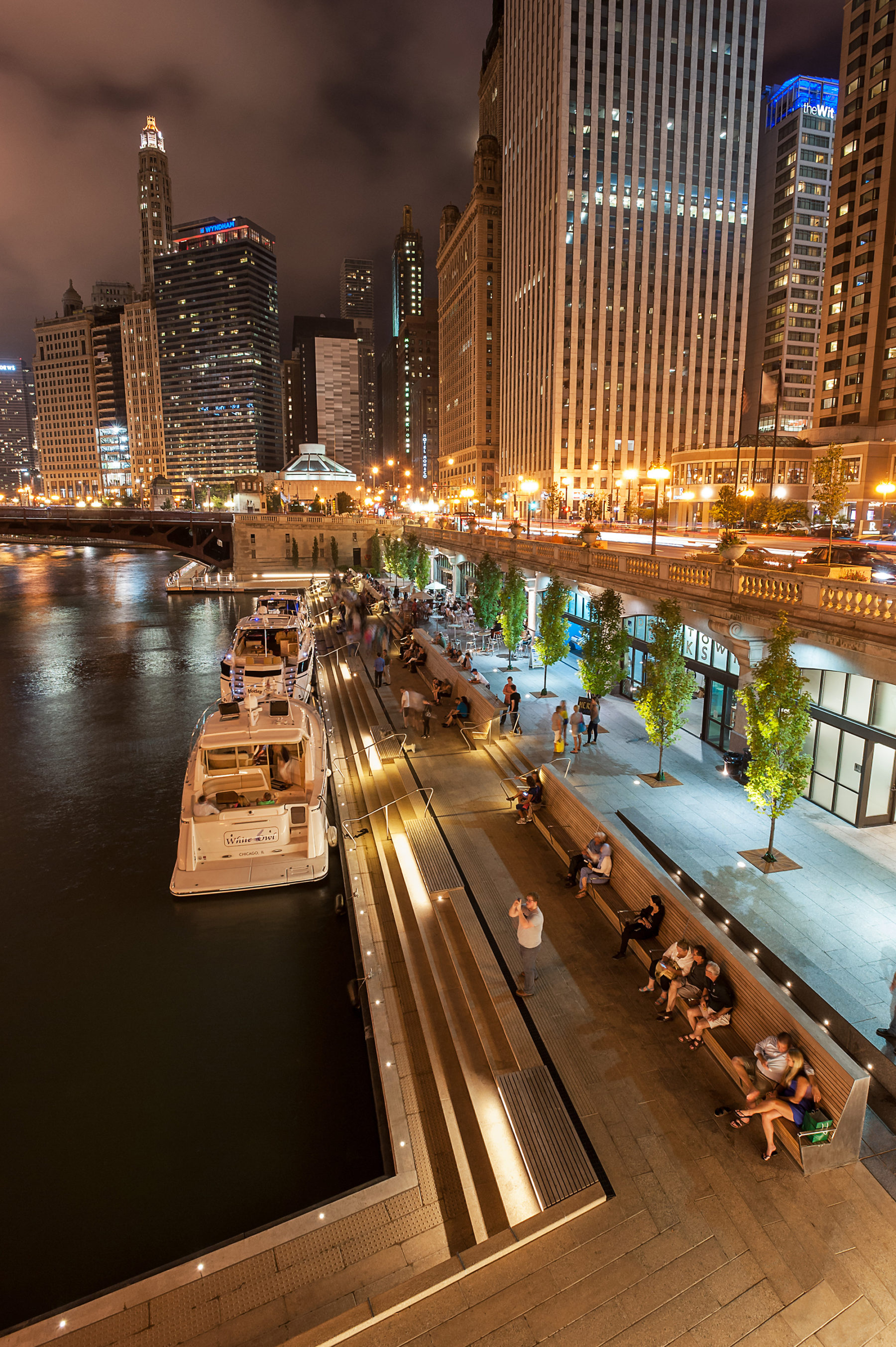
The lighting strategy for the Riverwalk is robust, playful, welcoming, and interactive. Vitality and excitement during the day and night is acheived by the unique lighting solutions implemented in each of the six rooms of the new Riverwalk.
Steps descend to nearly river level in the Marina Plaza providing users direct connection to the water
Restaurants and outdoor seating provide views of vibrant life on the water, including passing barges, patrols, water taxis, and sightseeing boats
Elegantly-detailed and custom high-backed teak benches provide great place to sit and watch life on the river and create a dramatic edge to the new Riverwalk walkway
Since it’s opening, the Riverwalk has become a beloved destination by Chicagoans and visitors alike
The lighting strategy for the Riverwalk is robust, playful, welcoming, and interactive. Vitality and excitement during the day and night is acheived by the unique lighting solutions implemented in each of the six rooms of the new Riverwalk.
The Cove
Inspired by beach landscapes, the flat concrete benches are reminiscent of beach stones, while the planting concept was beach grasses and wetland plants near the edge and trees with woodland ferns in the corners
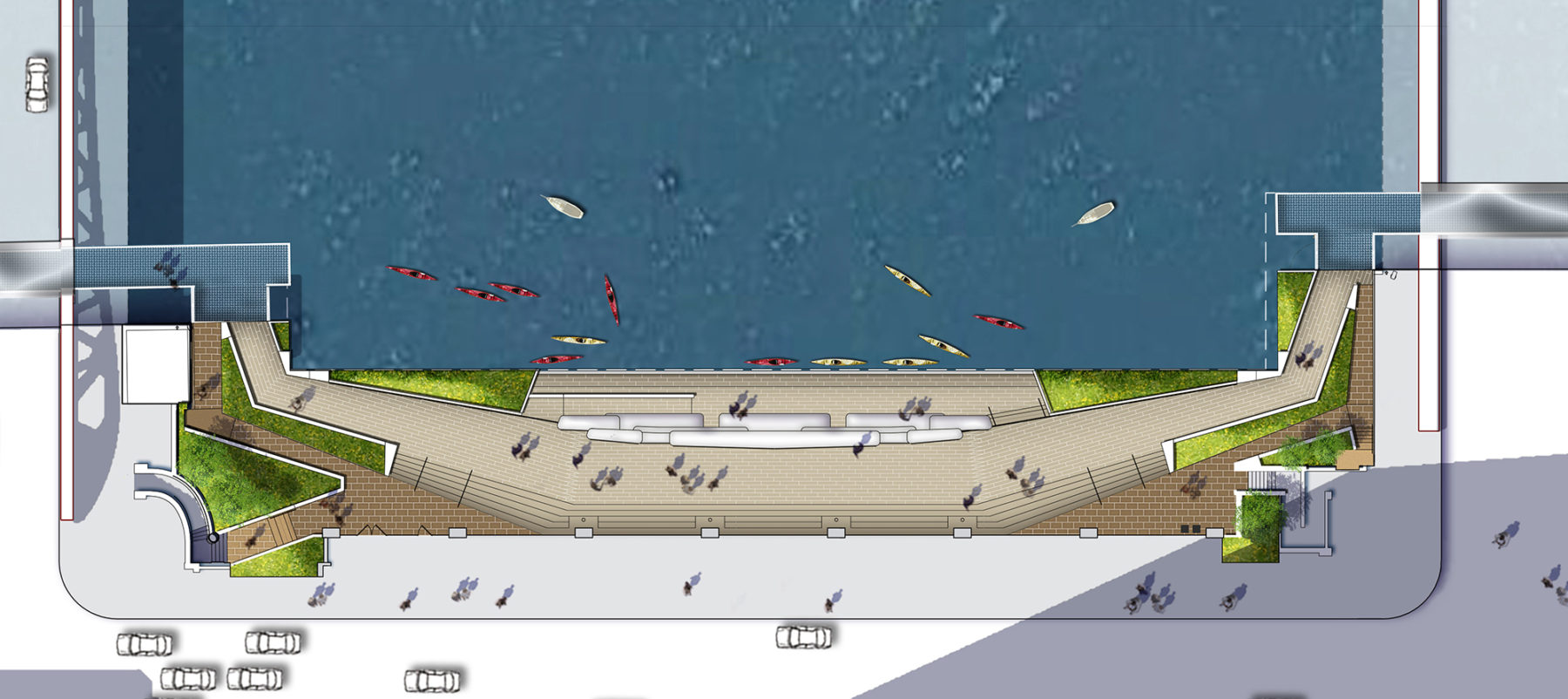
The Cove
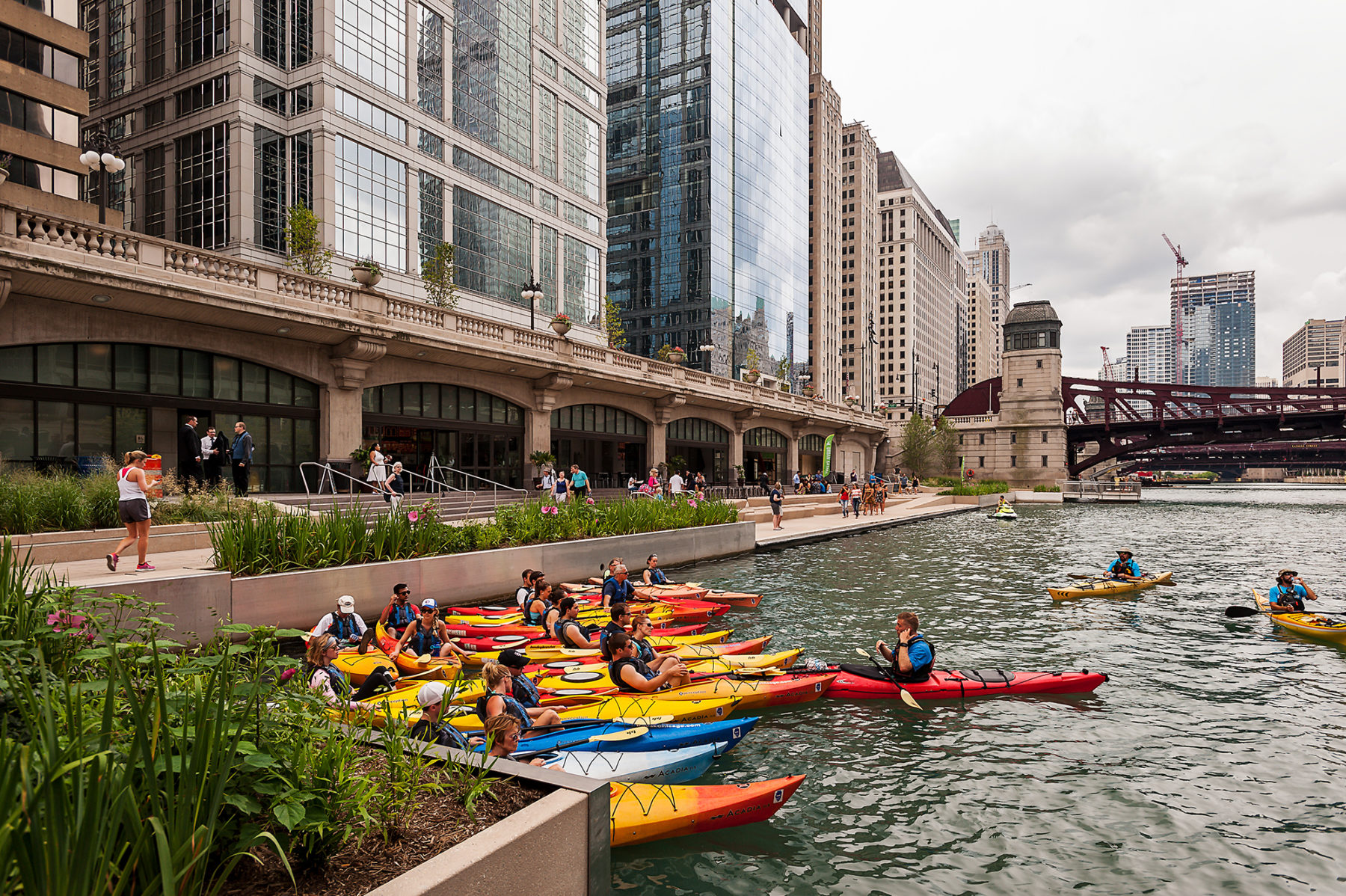
Kayak rentals and docking for human-powered craft provide physical connections to the water through recreation
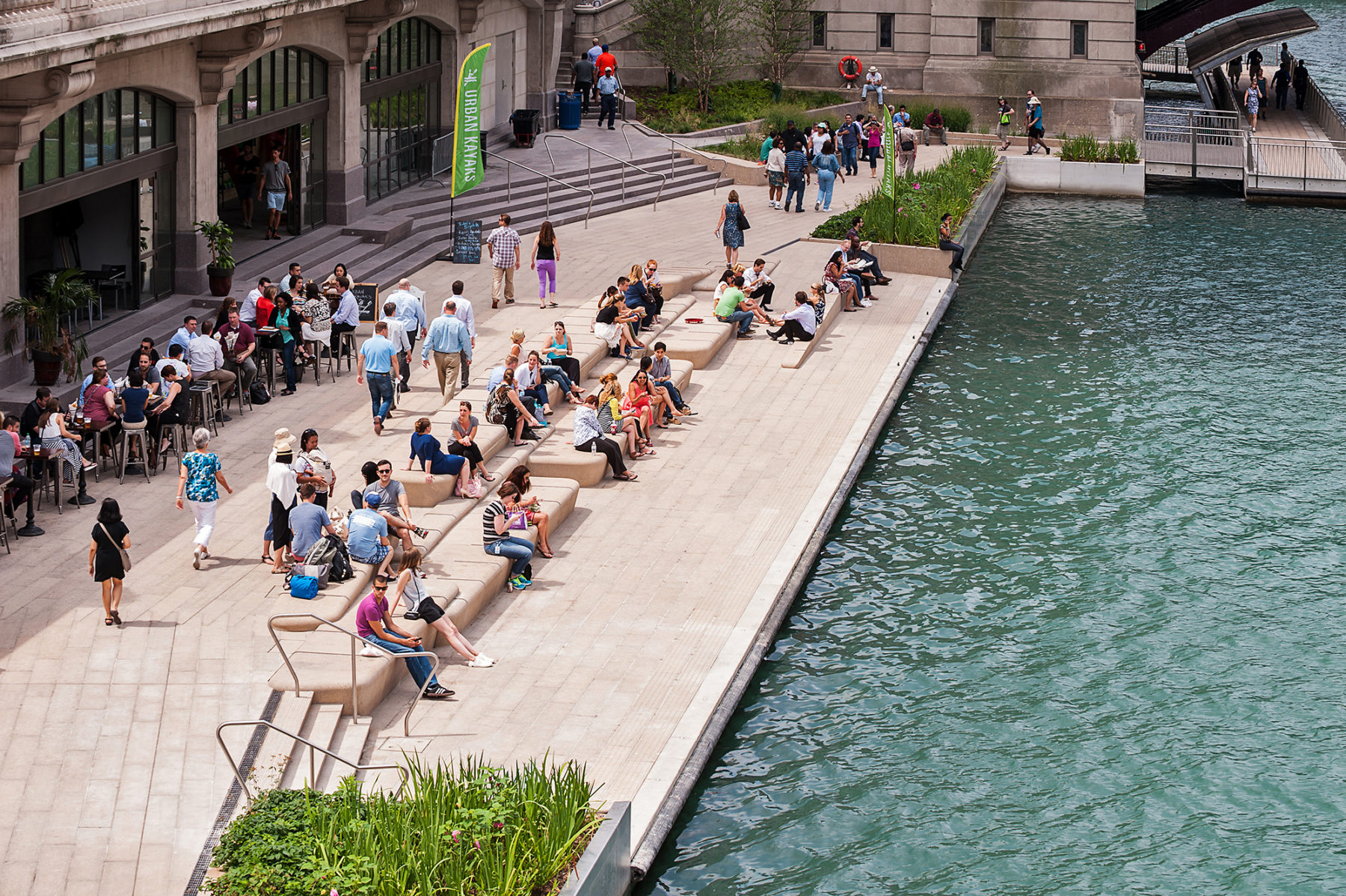
Custom precast seating elements capitalize on the shallow grade changes and create sunny places for sitting near the river’s edge
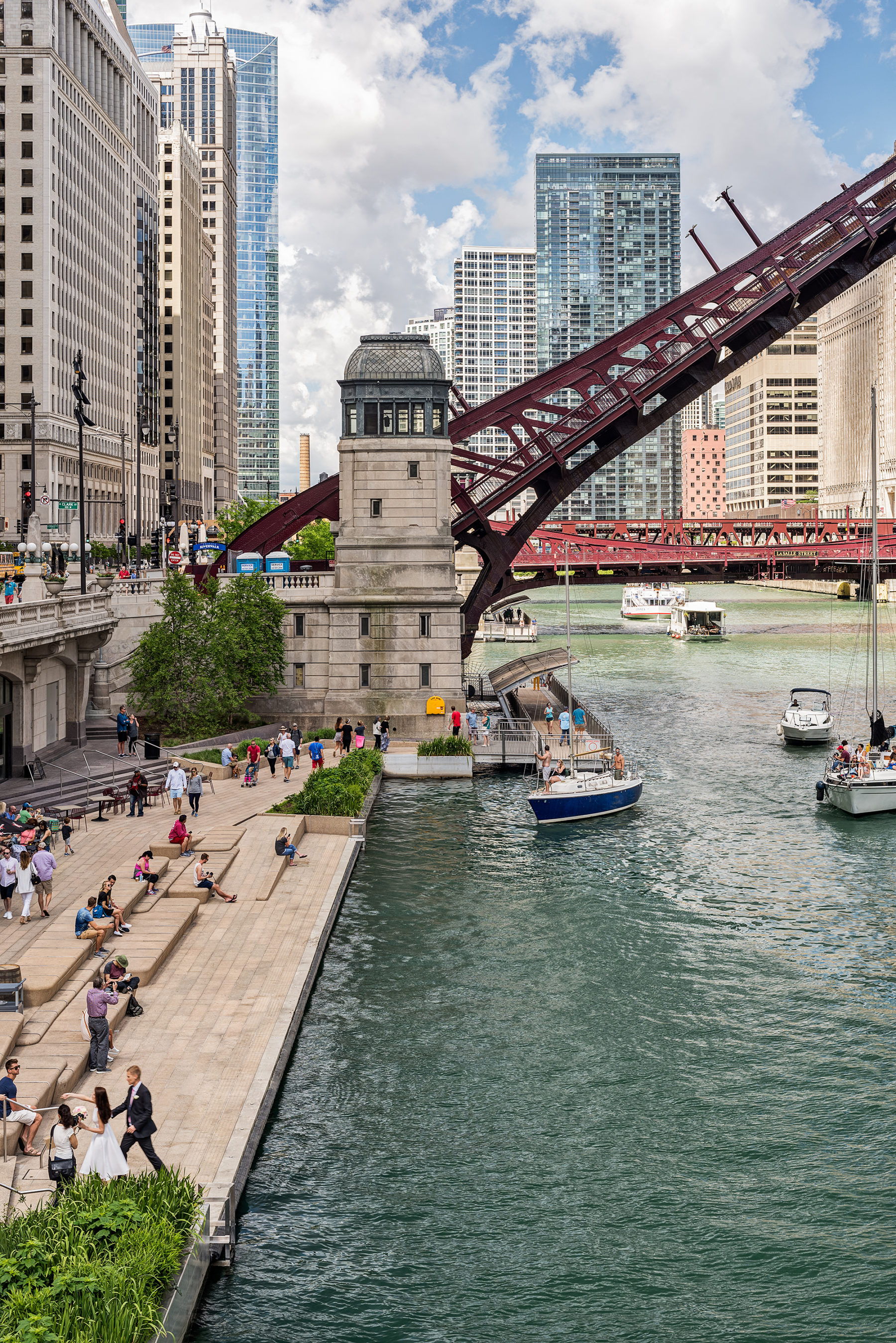
One of the design team’s main goals was to connect the life of the city to the growing recreational use of the river itself. To do so, the team brought the new pathway elevation as close as possible to the existing normal river elevation, enabling all forms of boat and small craft docking.
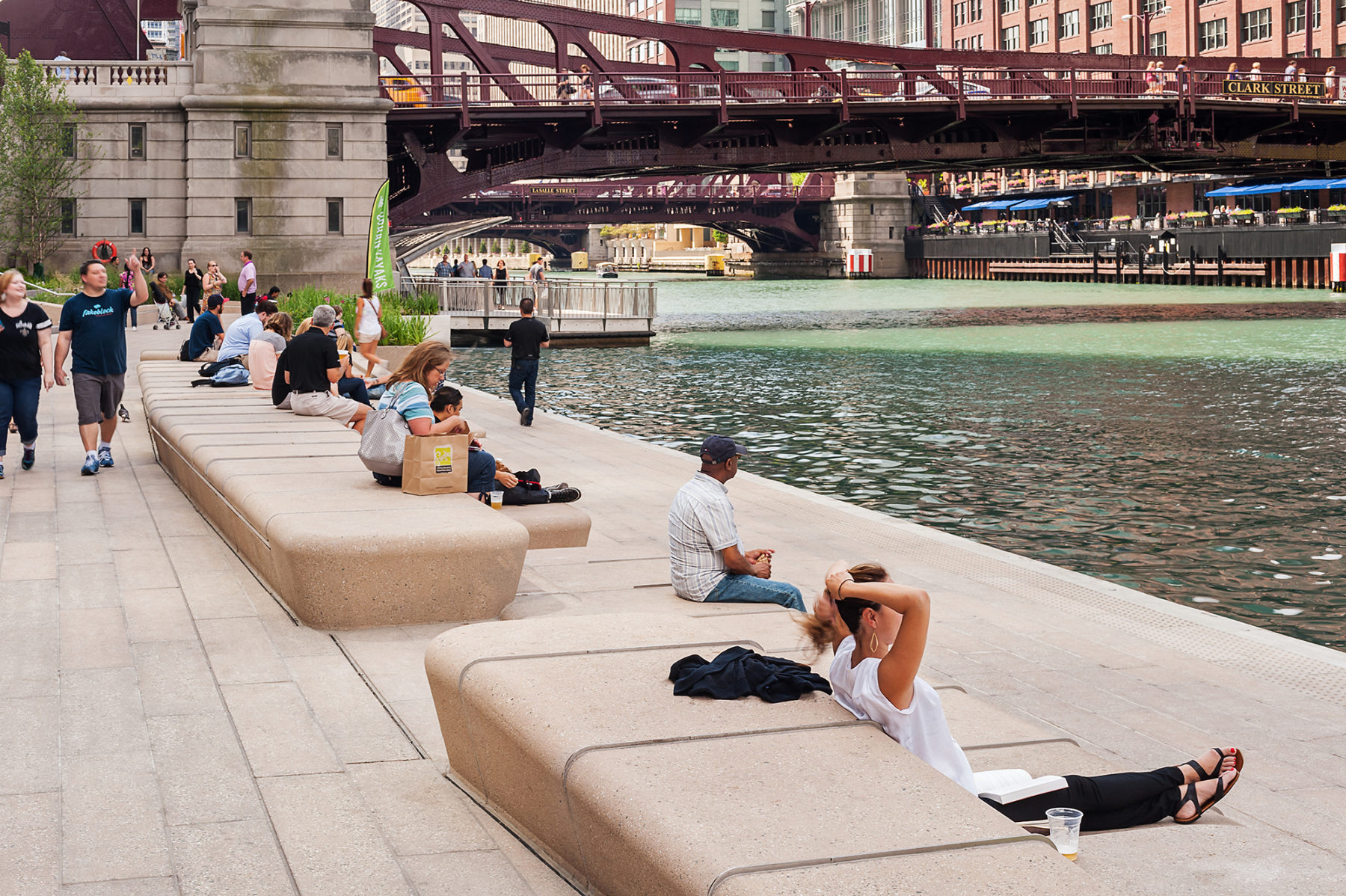
Custom precast seating elements capitalize on the shallow grade changes and create sunny places for sitting near the river’s edge
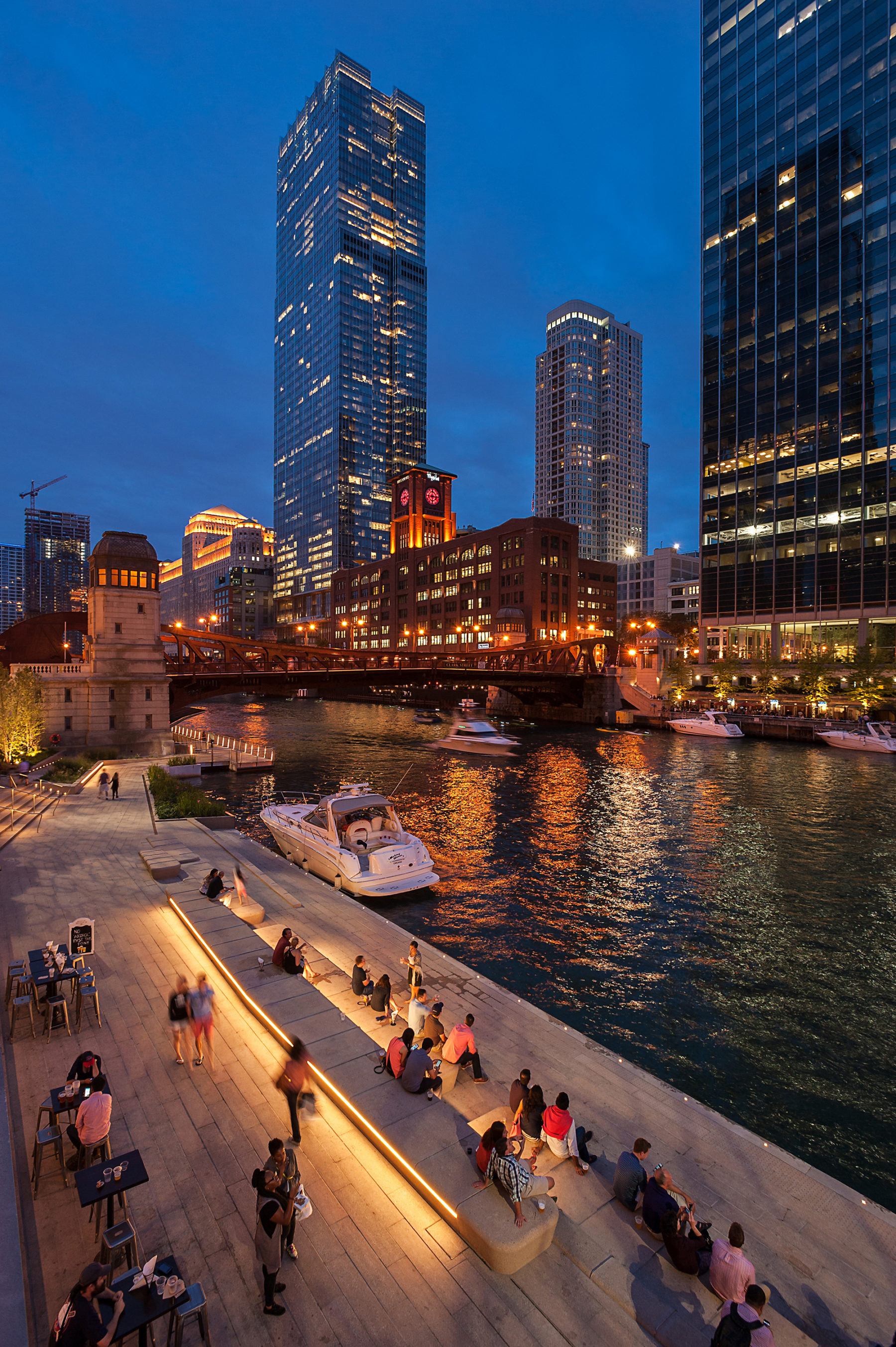
The lighting in each room was designed as soft and subtle illumination so that space for light poles could be better purposed
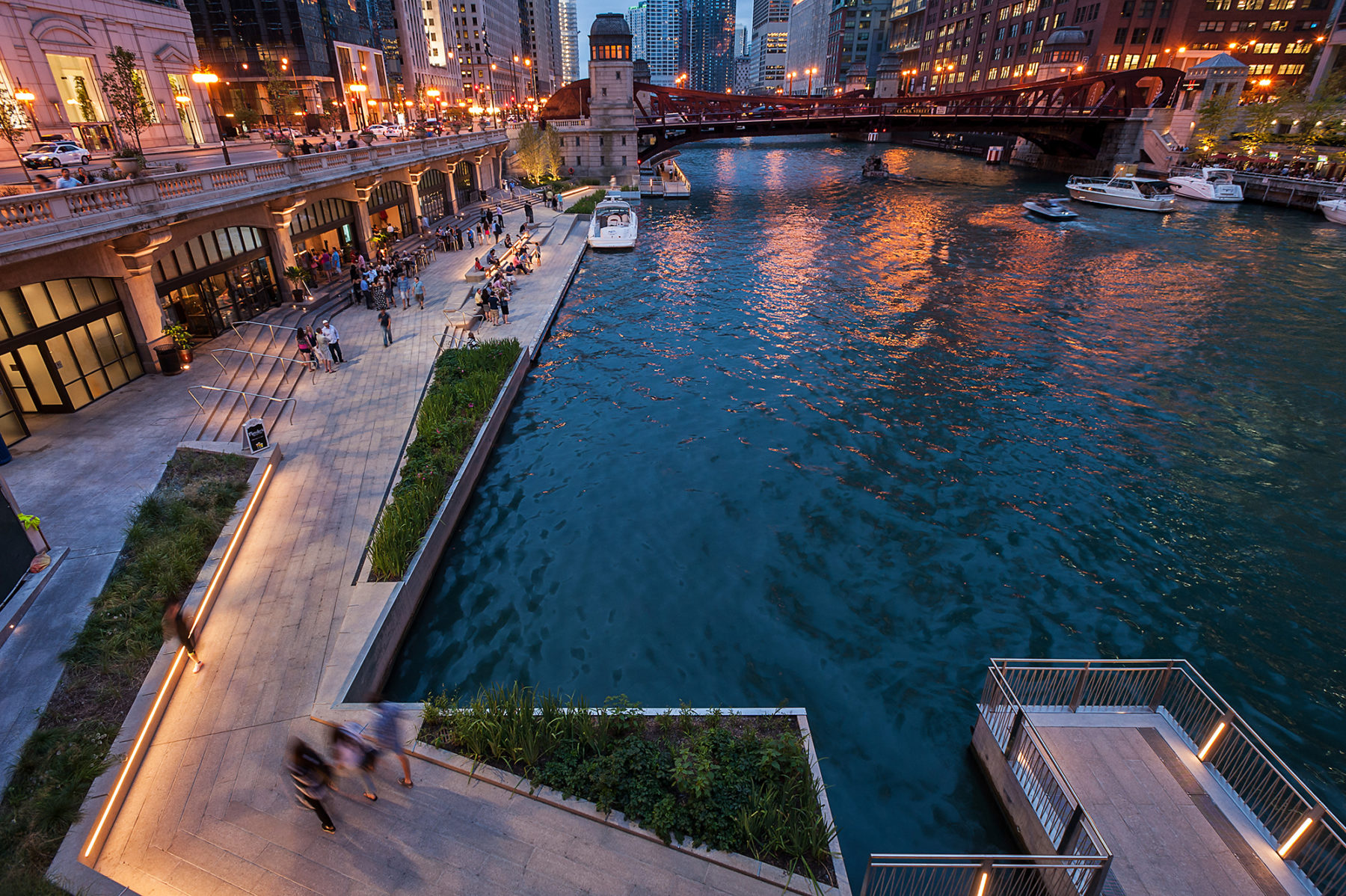
Integrated LED lighting provides texture at the pedestrian scale and clarifies edges for safety
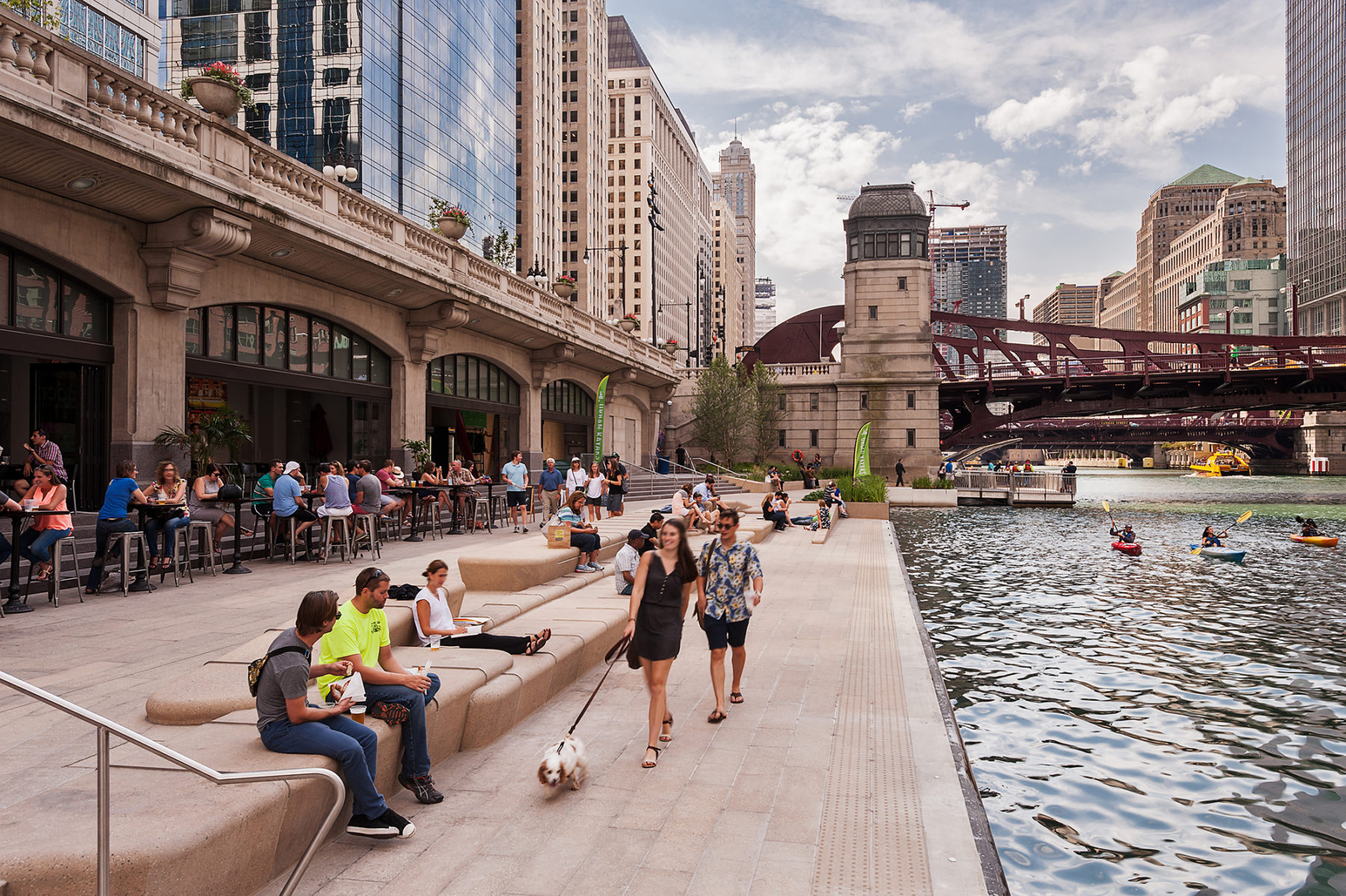
To accommodate the river’s annual flood dynamics of nearly seven vertical feet, all elements of the project—planting, lighting, paving, etc.—were designed to be resilient to annual inundation
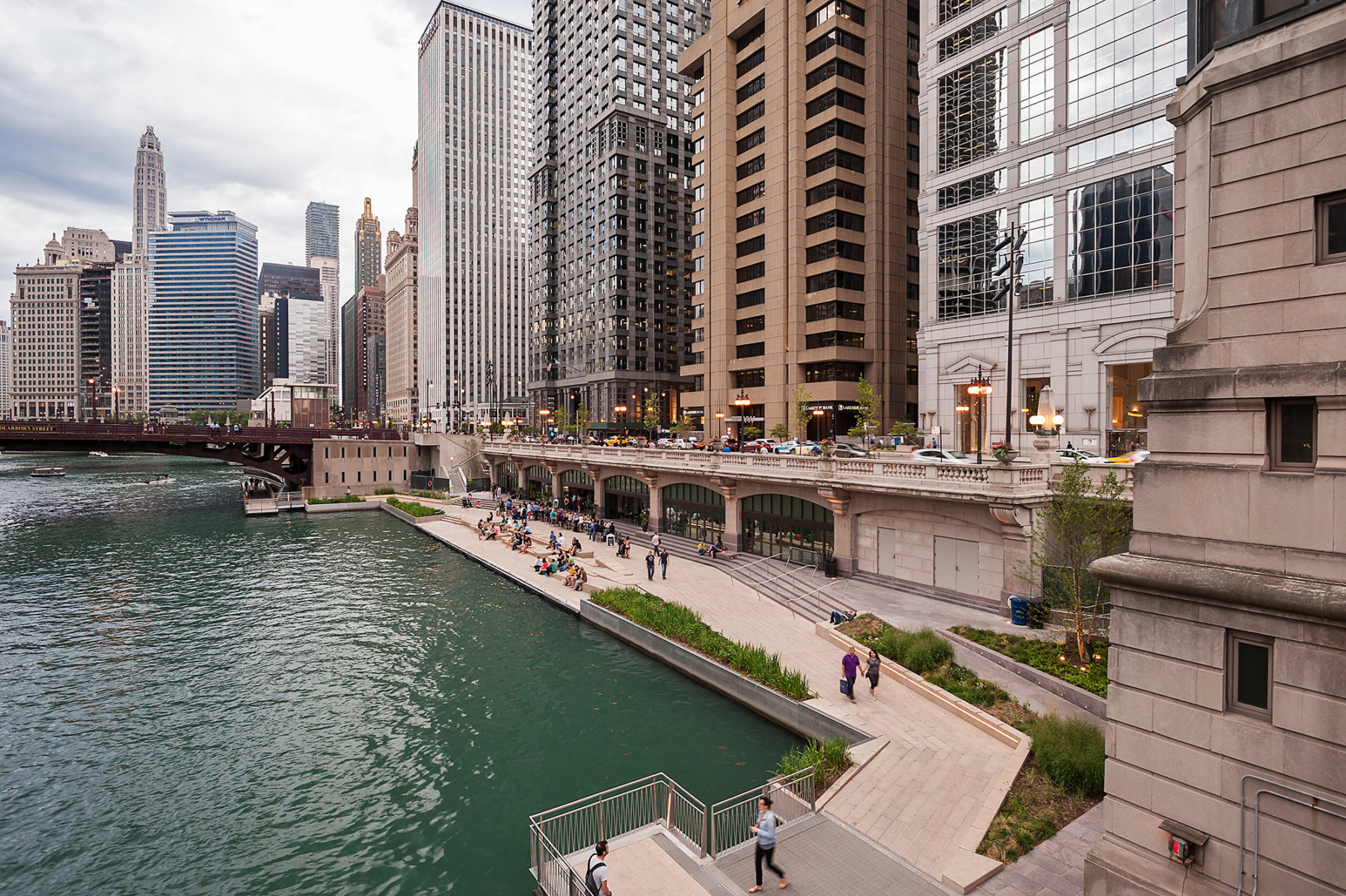
Plantings in the lower tiers are also tolerant of inundation because the room was designed to be flooded during a storm event
Custom precast seating elements capitalize on the shallow grade changes and create sunny places for sitting near the river’s edge
One of the design team’s main goals was to connect the life of the city to the growing recreational use of the river itself. To do so, the team brought the new pathway elevation as close as possible to the existing normal river elevation, enabling all forms of boat and small craft docking.
Custom precast seating elements capitalize on the shallow grade changes and create sunny places for sitting near the river’s edge
The lighting in each room was designed as soft and subtle illumination so that space for light poles could be better purposed
Integrated LED lighting provides texture at the pedestrian scale and clarifies edges for safety
To accommodate the river’s annual flood dynamics of nearly seven vertical feet, all elements of the project—planting, lighting, paving, etc.—were designed to be resilient to annual inundation
Plantings in the lower tiers are also tolerant of inundation because the room was designed to be flooded during a storm event
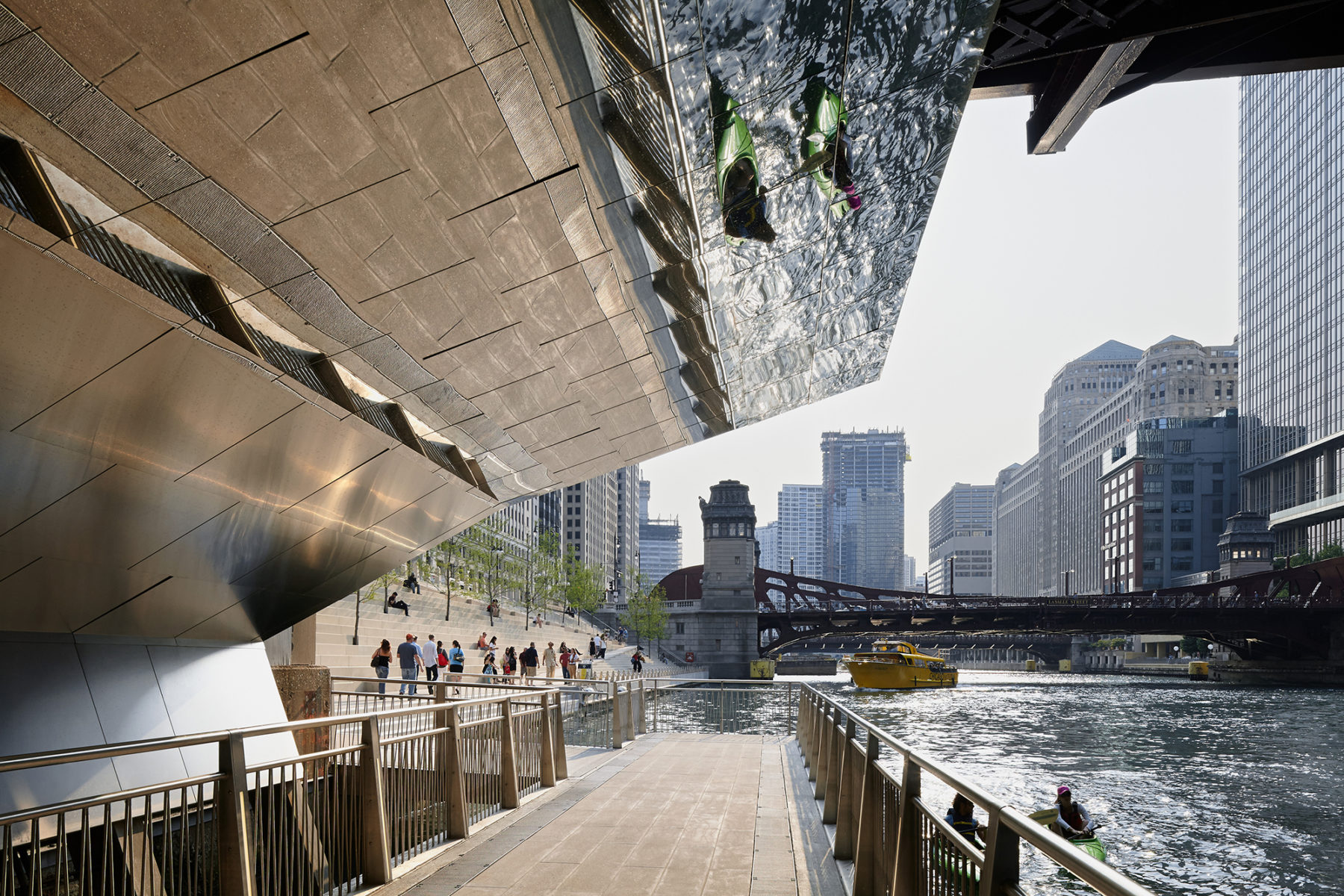
The project realizes six underbridge crossings under the existing bridge desks at each block, connecting blocks that previously had been discrete spaces. These stainless-steel-canopied mini-bridges both shelter pedestrians as they pass beneath the bridge deck above and reflect the texture and light of the river’s surface.
The River Theater
A sculptural staircase linking Upper Wacker and the Riverwalk offers pedestrian connectivity to the water’s edge and seating, while trees provide greenery and shade.
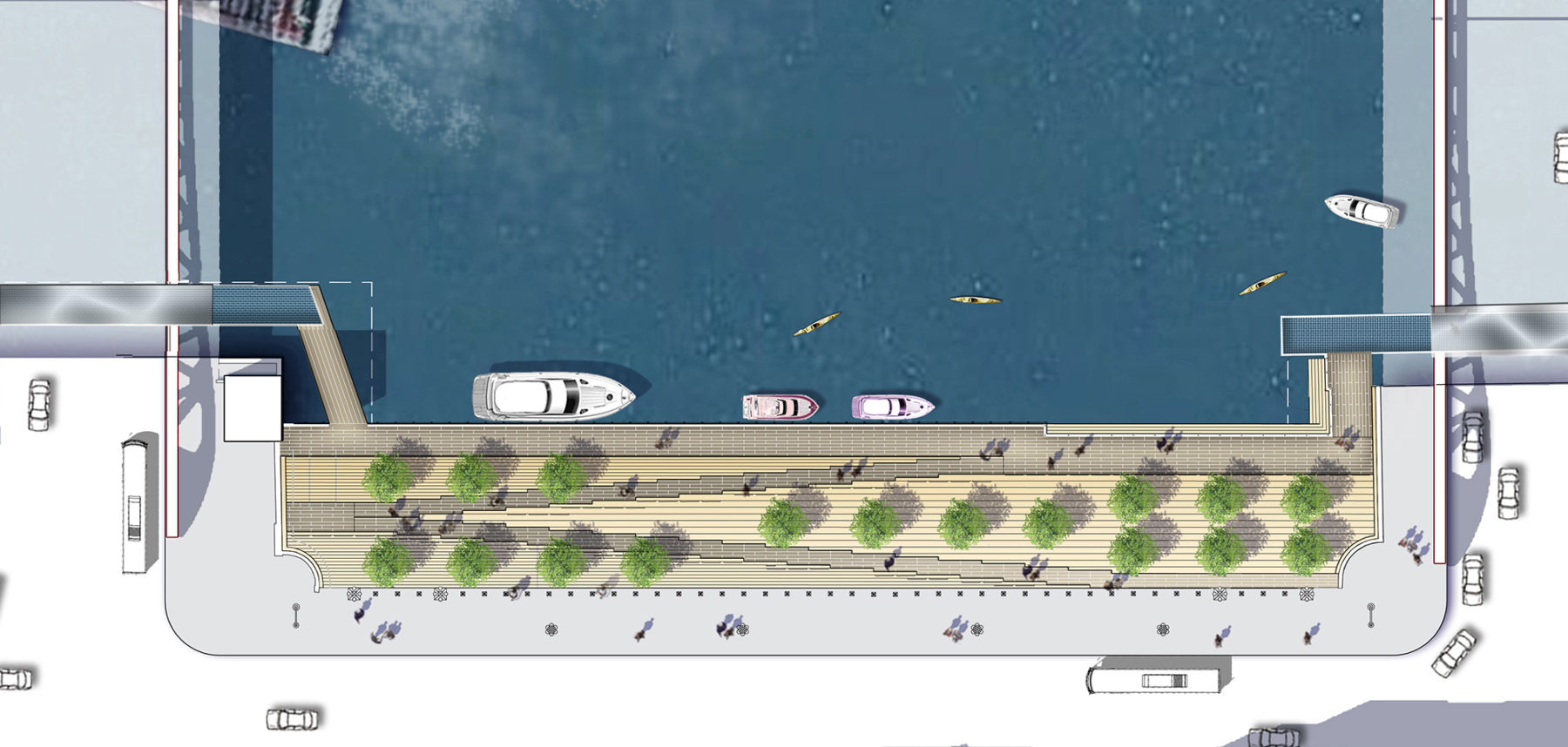
The River Theater
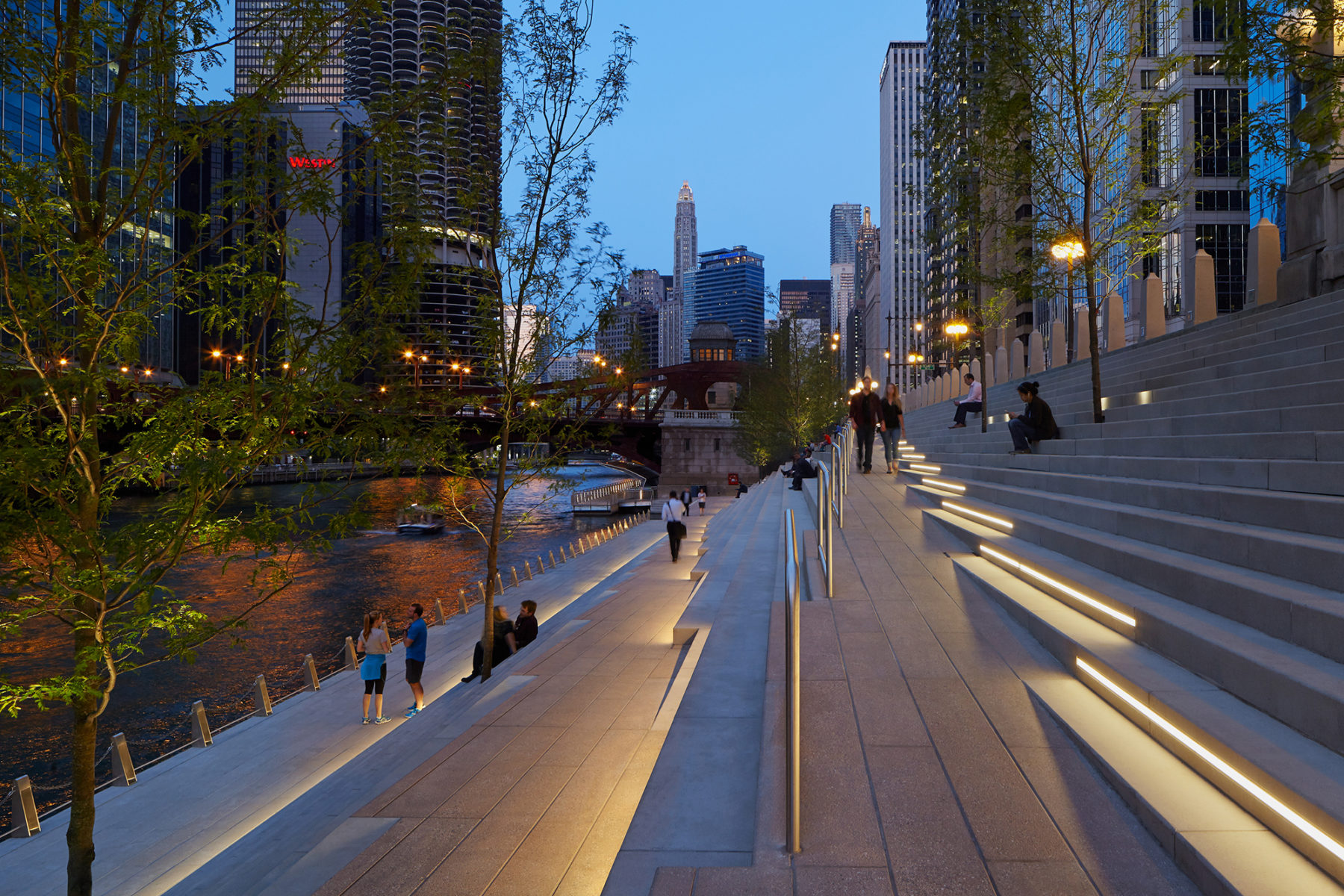
The River Theater was conceived as a space where Chicago’s streetscape folds down to the river in a smooth and dynamic way. It offers itself as a unique setting for years to come, treating downtown visitors to a perhaps unexpected place of both quiet reflection and dynamic excitement.
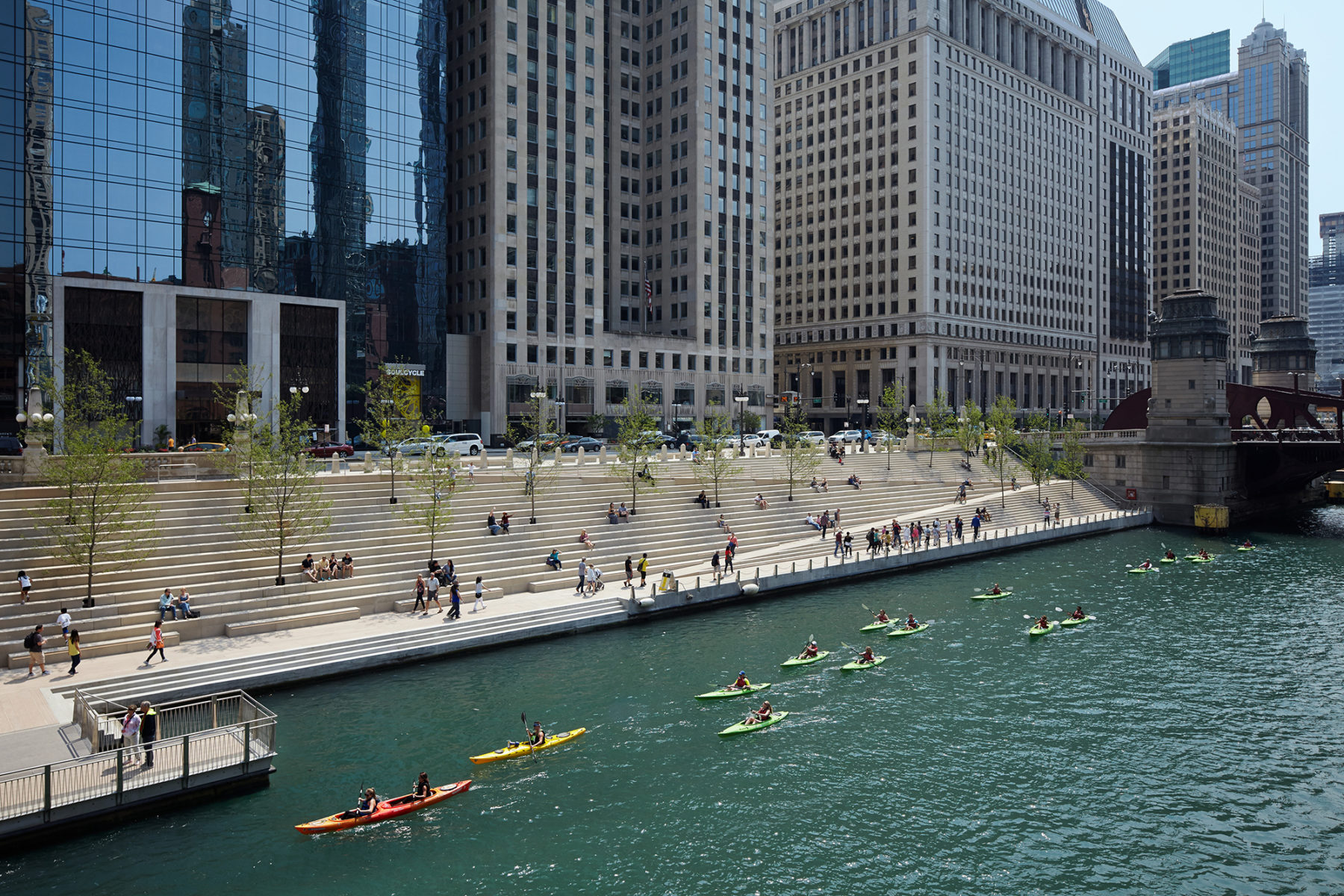
This room links the streets to the river’s edge through a grand set of dynamic steps that support staged events and watching the theater of the river
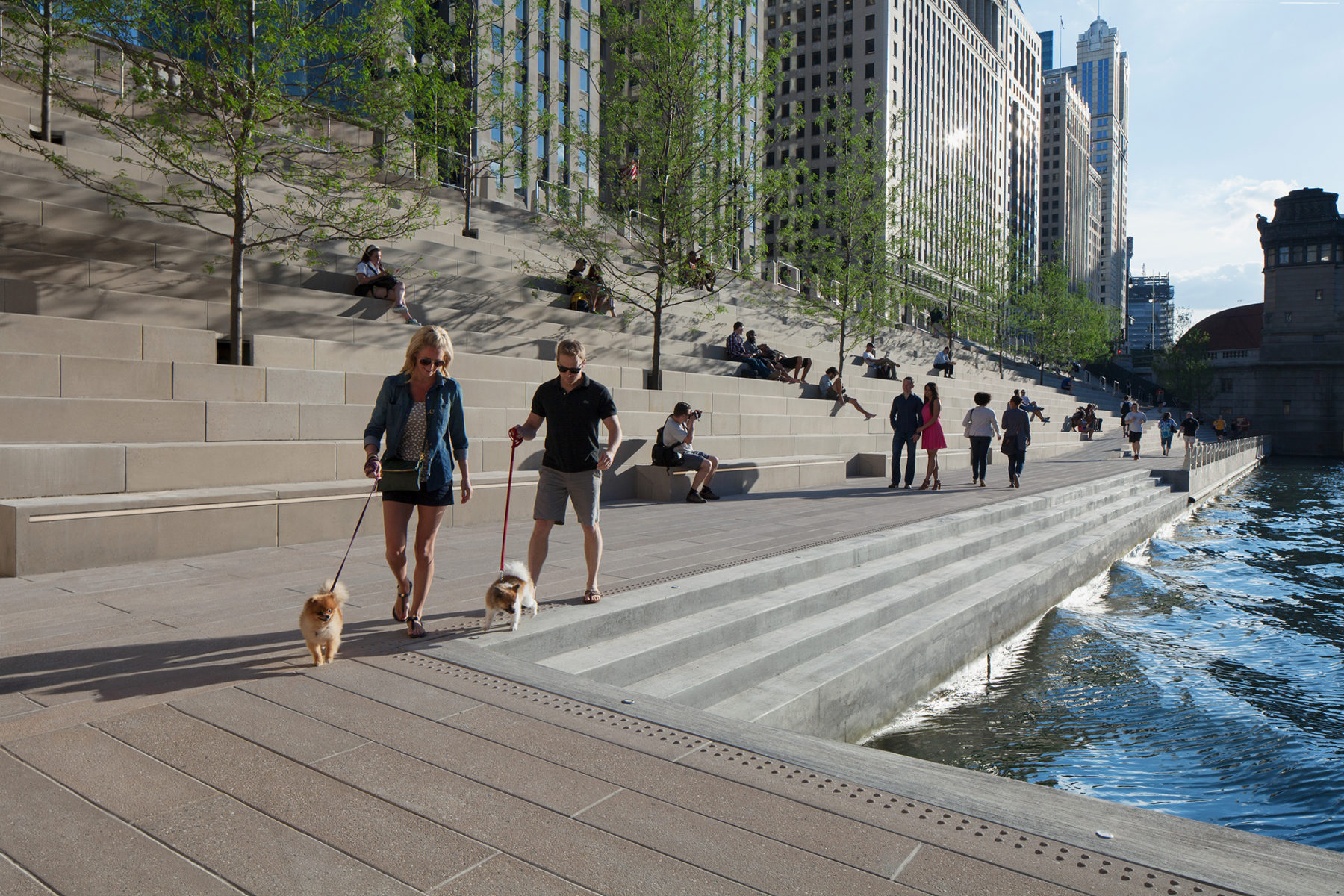
Trees are integrated into the staircase with a custom design
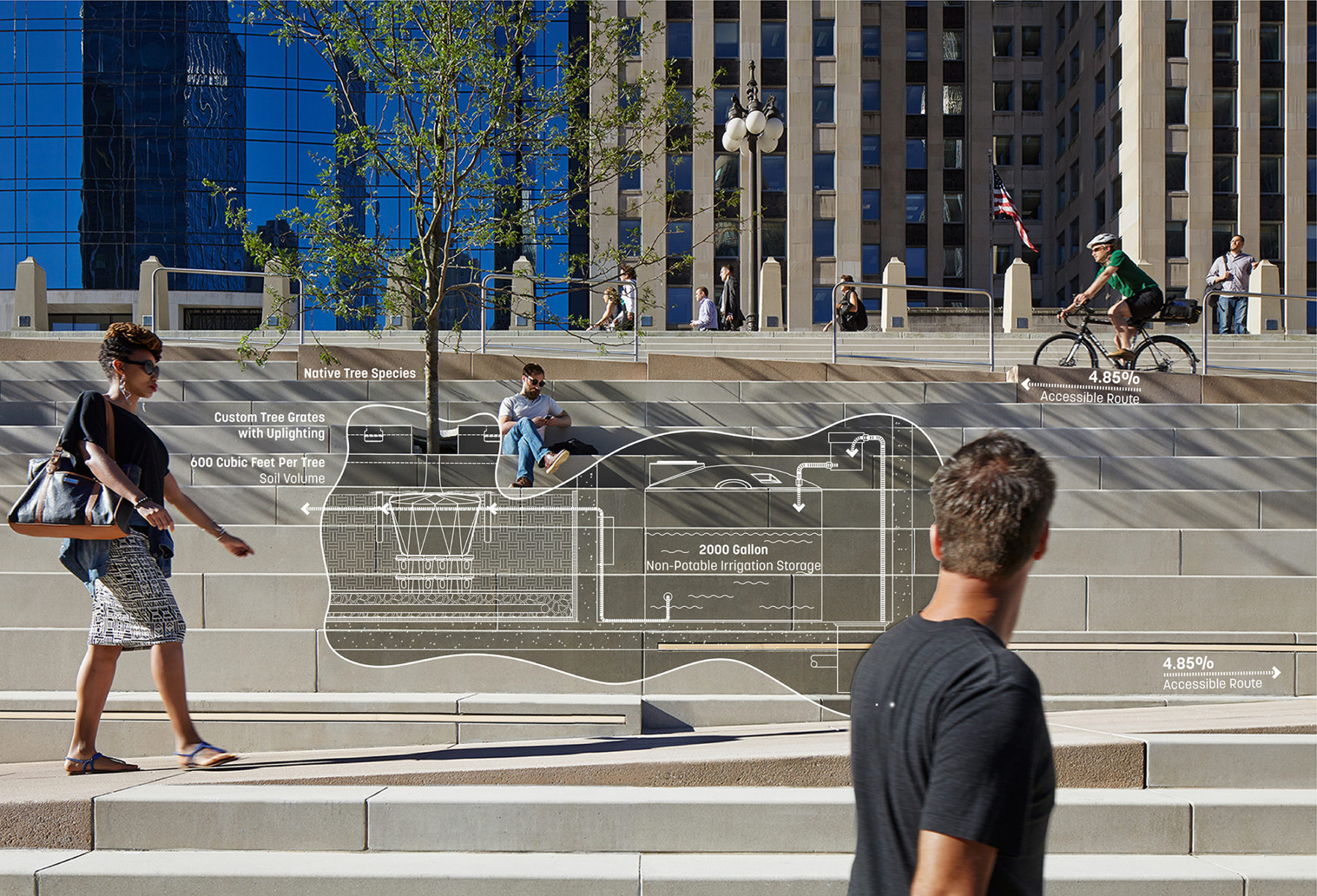
Long-term tree health is supported project-wide with structural paving systems to enable appropriate soil volumes and irrigation using reclaimed stormwater
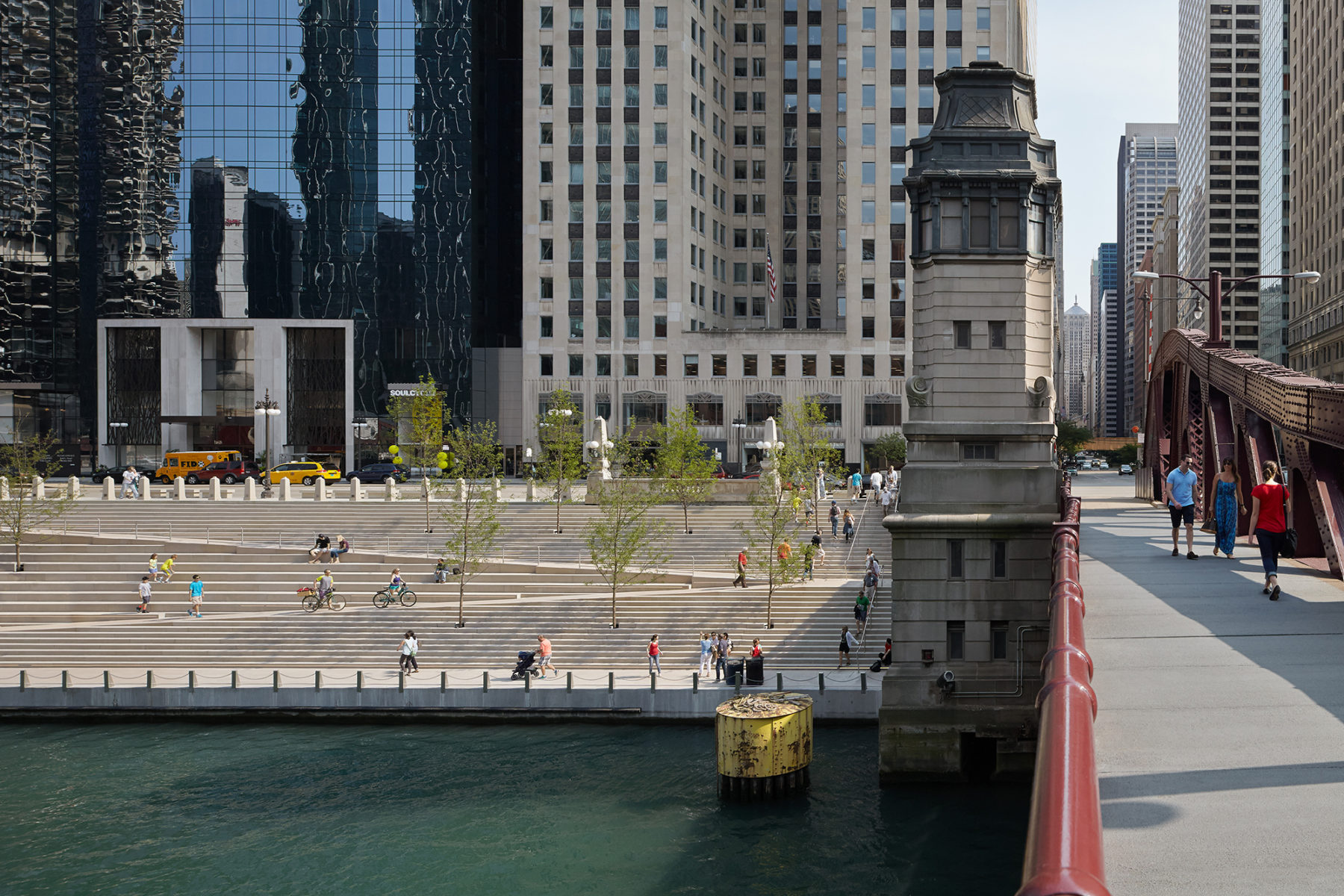
A fully-accessible geometric path is the central circulation feature in the River Theater
This room links the streets to the river’s edge through a grand set of dynamic steps that support staged events and watching the theater of the river
Trees are integrated into the staircase with a custom design
Long-term tree health is supported project-wide with structural paving systems to enable appropriate soil volumes and irrigation using reclaimed stormwater
A fully-accessible geometric path is the central circulation feature in the River Theater
The Water Plaza
A water feature offers an opportunity for children and families to engage with water at the river’s edge.
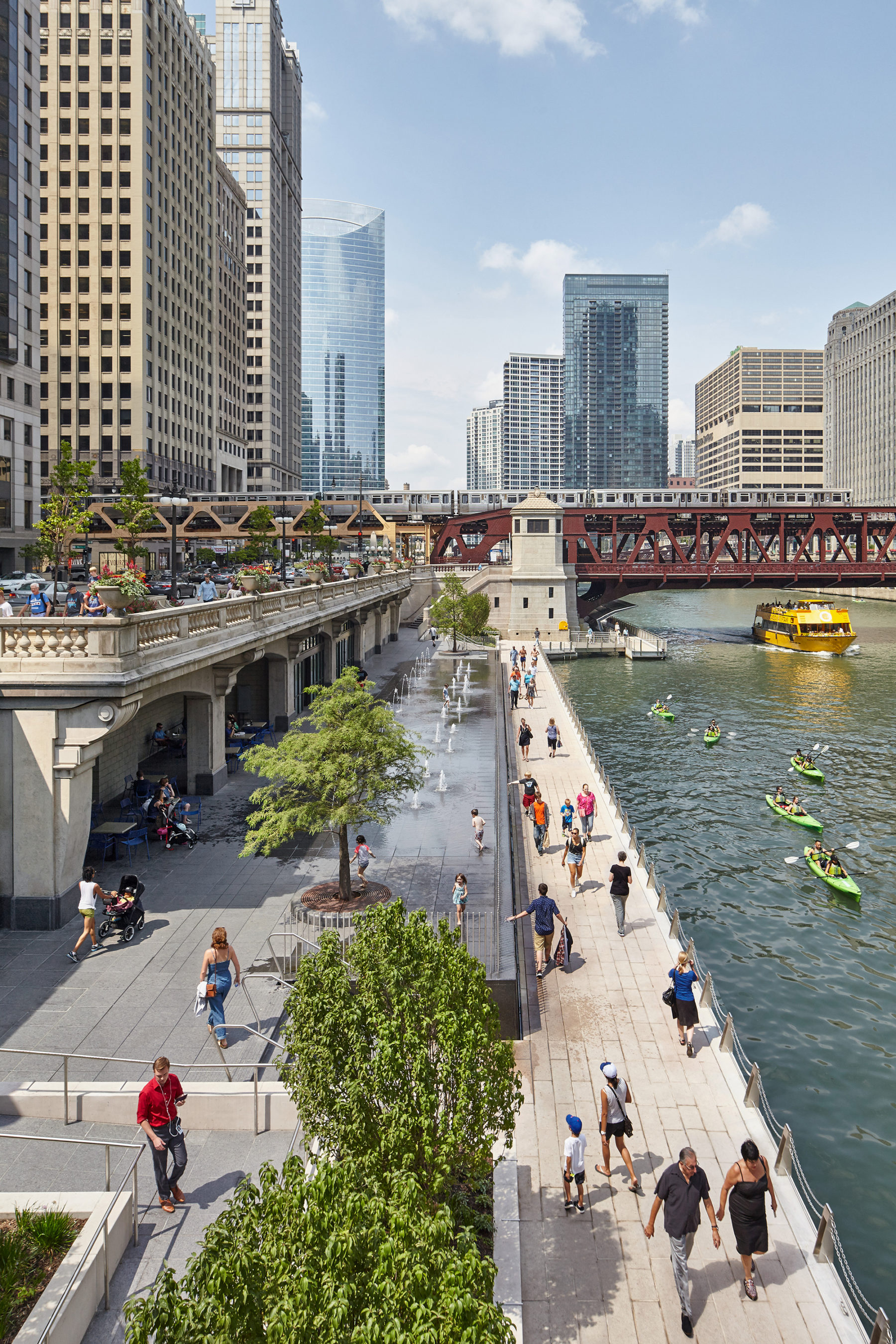
The fountain in the Water Plaza allows users to interact with water next to the river’s edge
The Jetty
A series of piers and floating wetland gardens offer an interactive learning environment about the ecology of the river, including opportunities for fishing and identifying native plants.
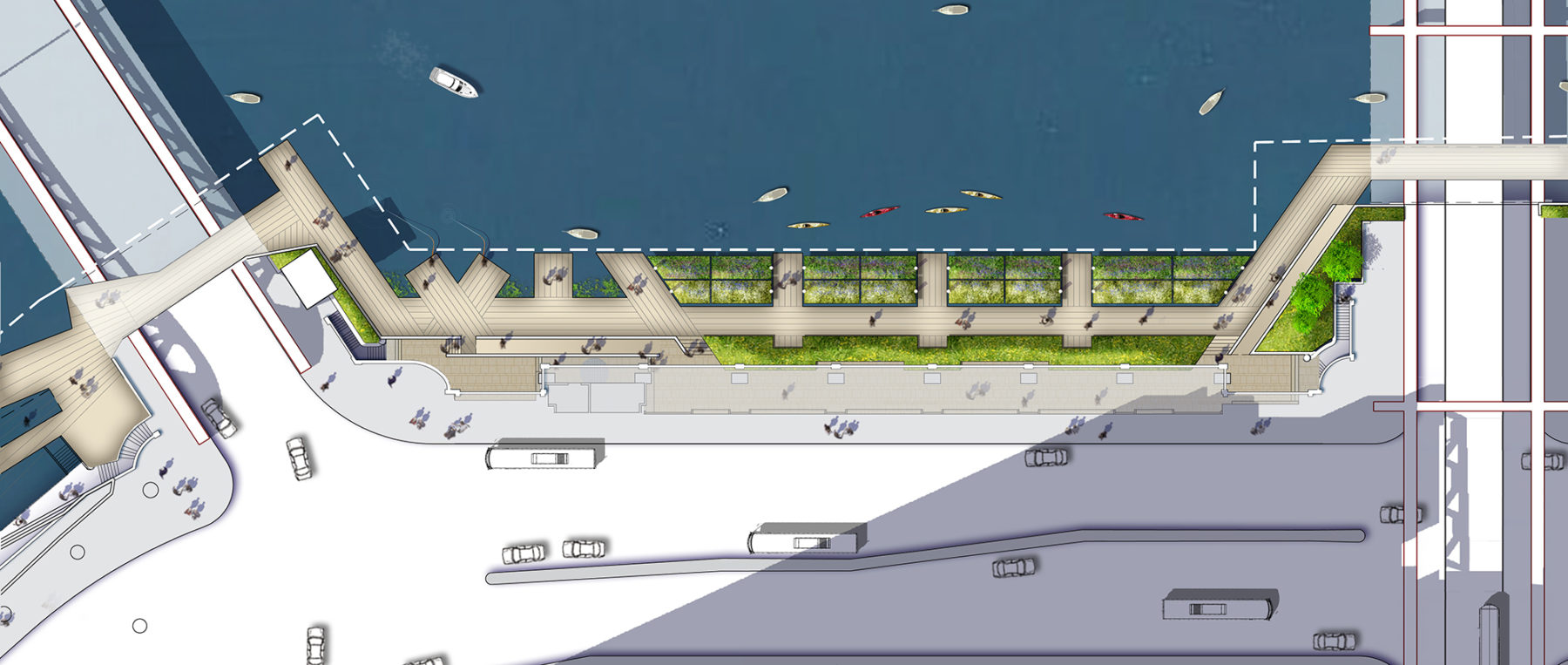
The Jetty
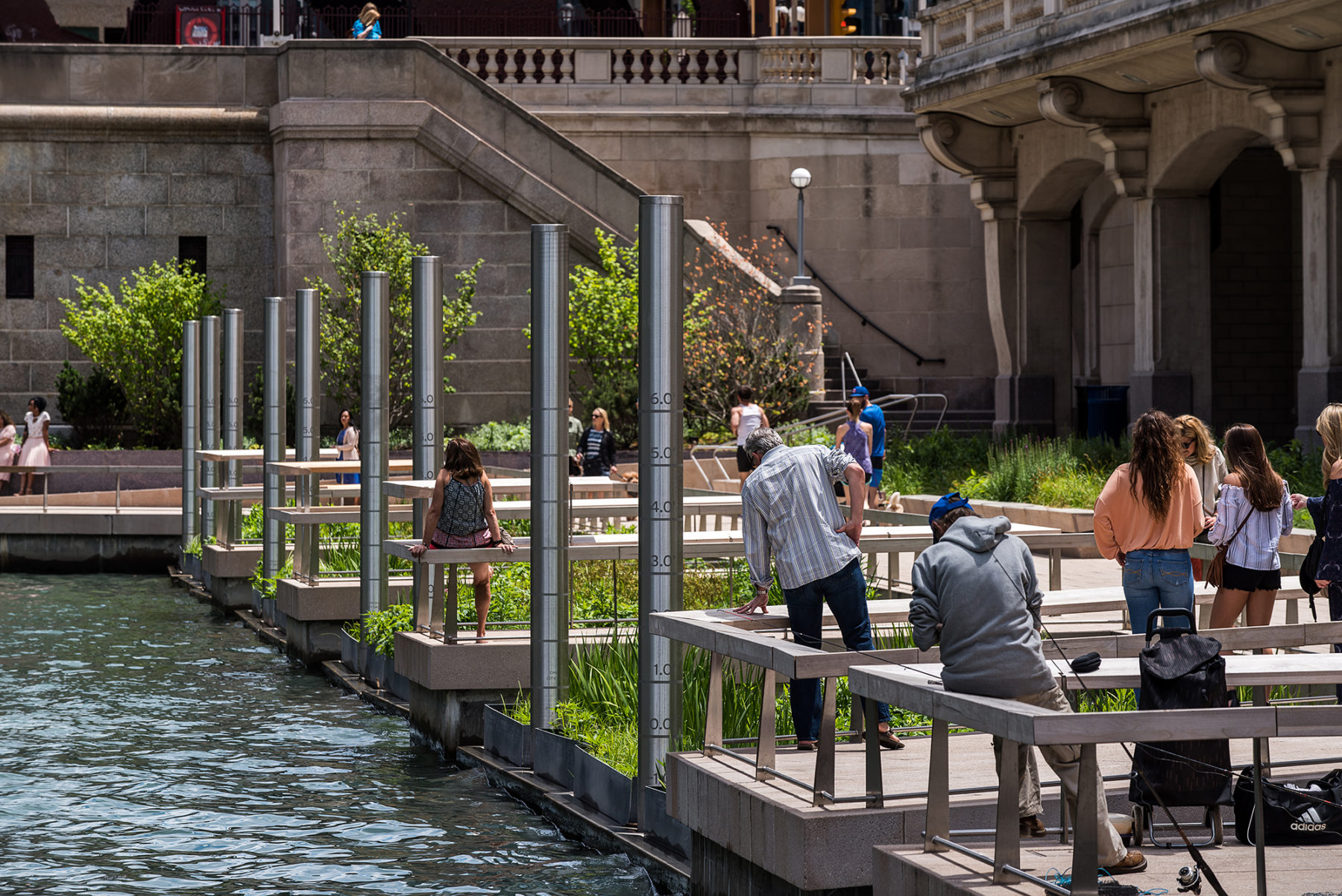
The Jetty’s floating wetlands provide a healthy habitat for the Chicago River’s diverse native fish population, as well as educational and recreational opportunities for visitors to observe and interact with the aquatic ecosystem
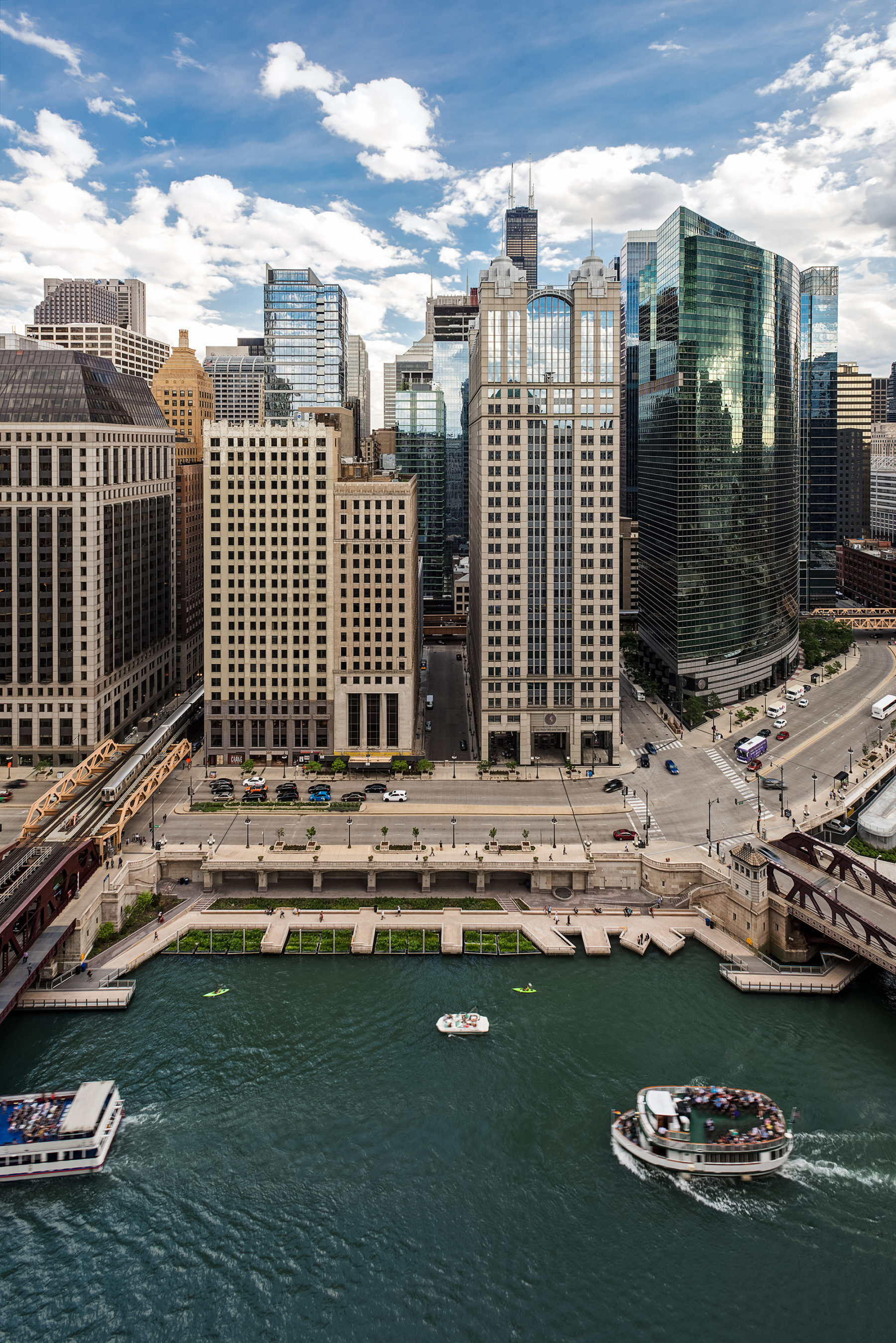
A series of piers and floating wetland gardens offers an interactive learning environment about the ecology of the river, including opportunities for fishing and identifying native plants
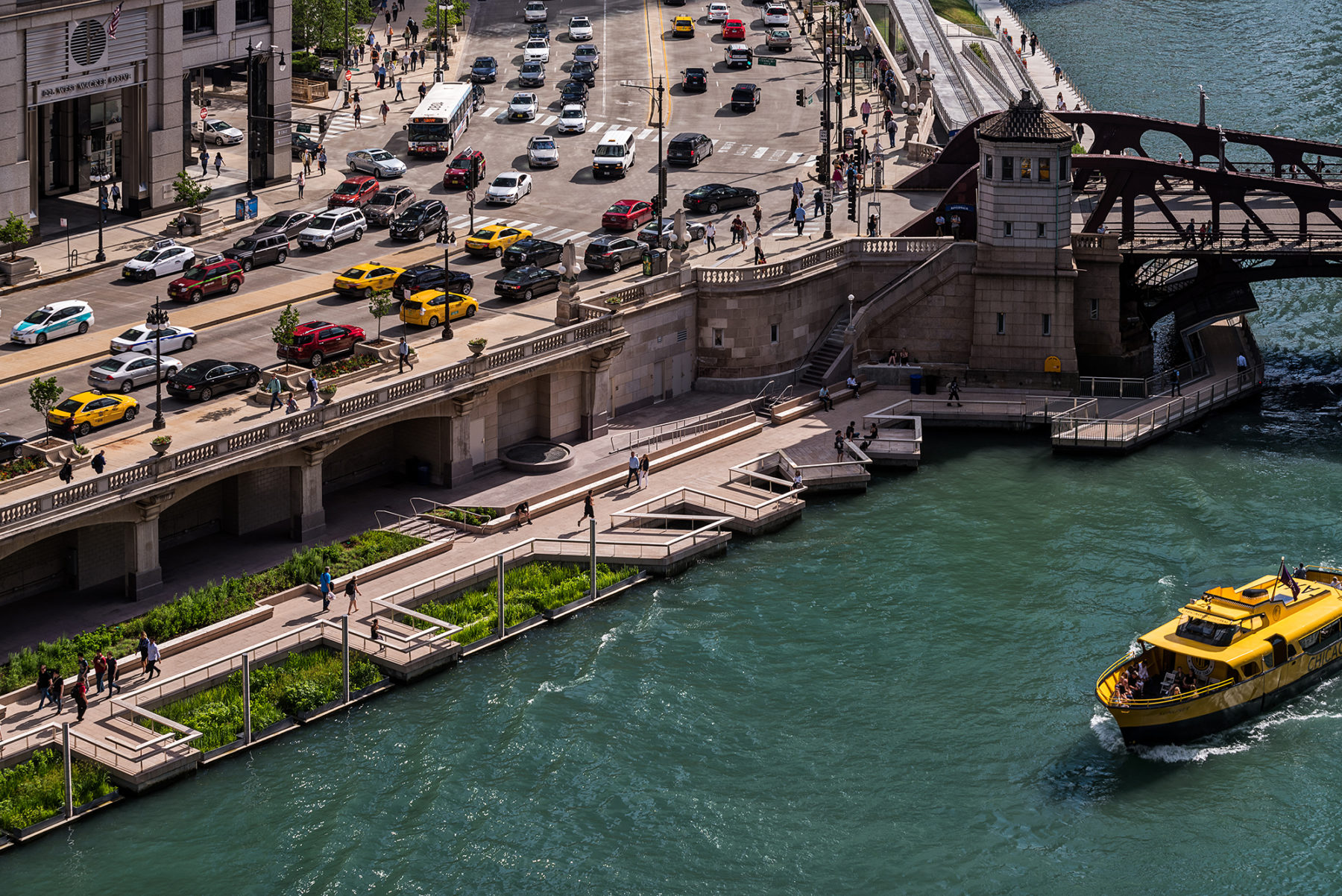
The new connective spaces of the Riverwalk also act as critical linkages to existing open space systems in the city
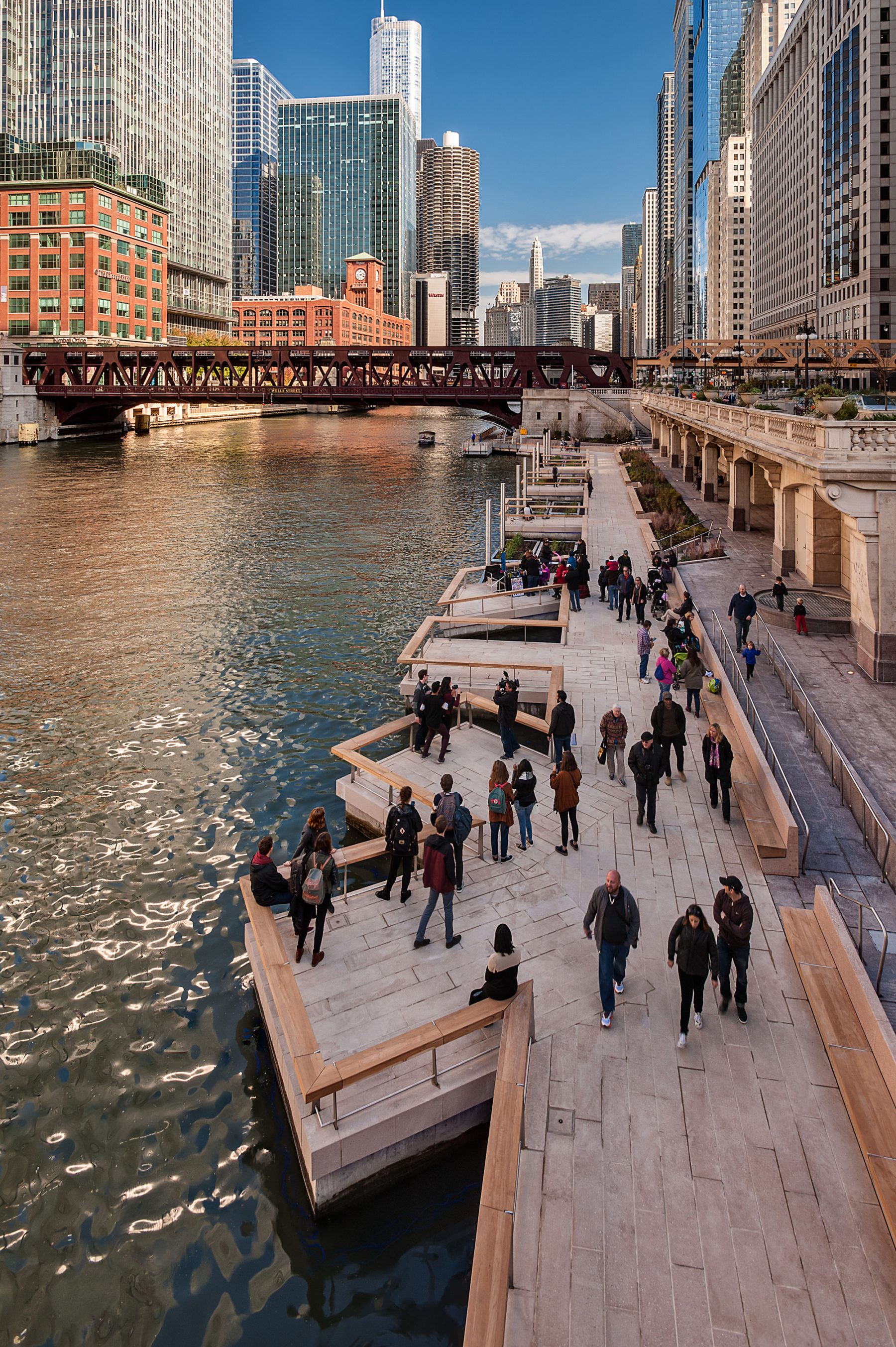
The Jetty gets it name from the seven narrow piers, or jetties, that extend into the river
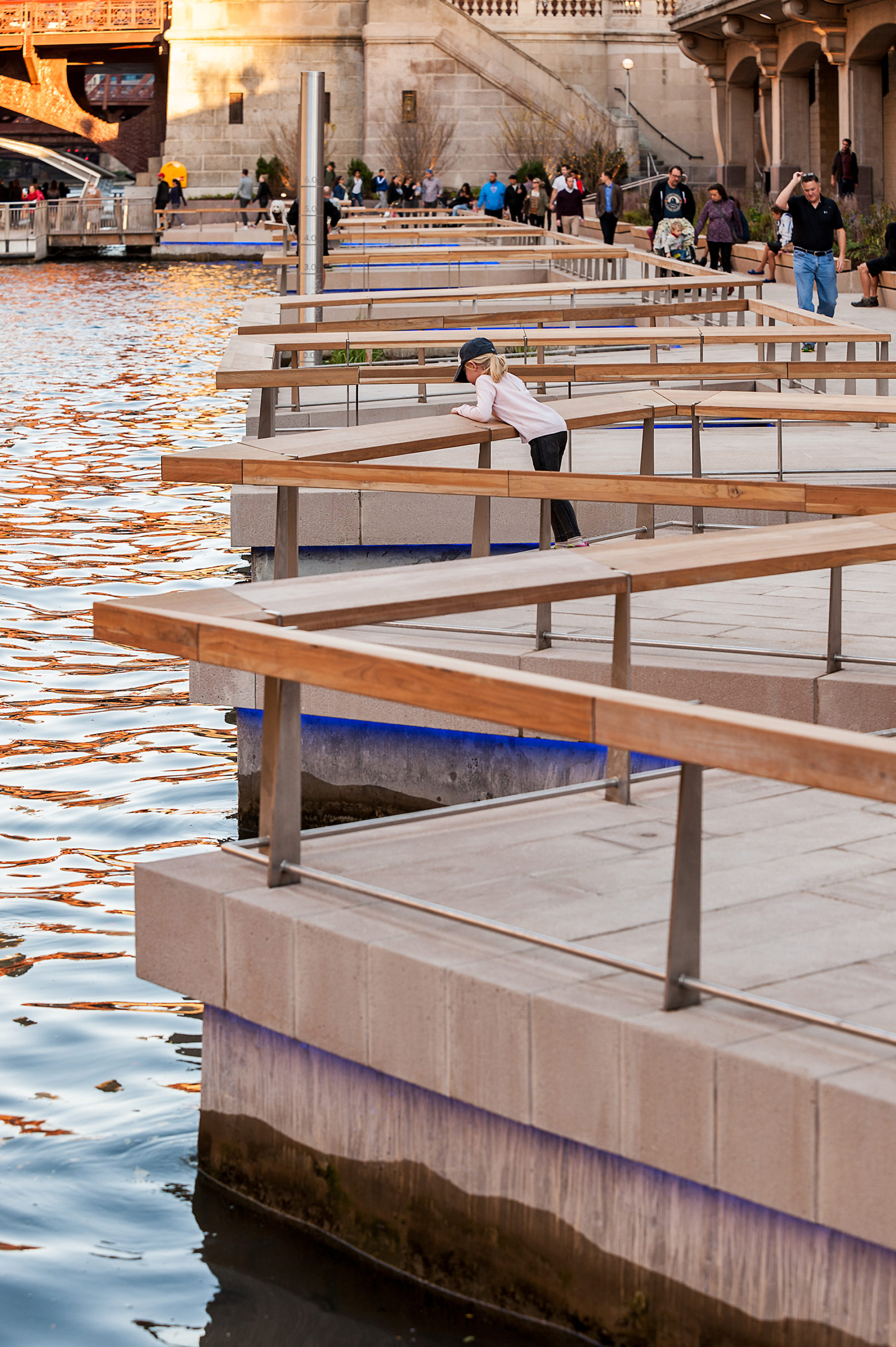
Accessible height railings ensure all are able to enjoy views of the river
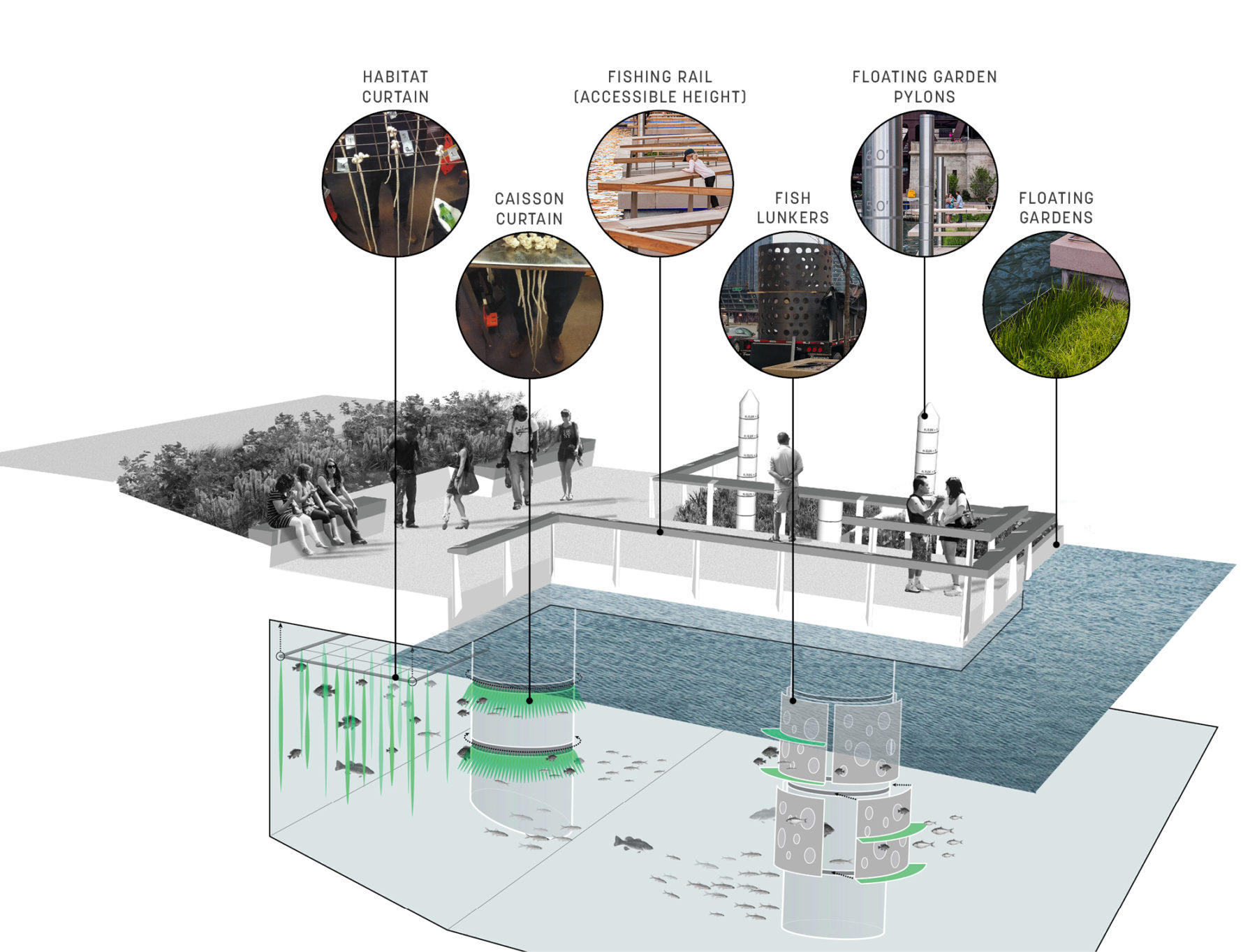
The Jetty also incorporates several innovative and low-cost features—lunkers, curtains, and hulas—that will ensure a great experience for those species who live below the surface
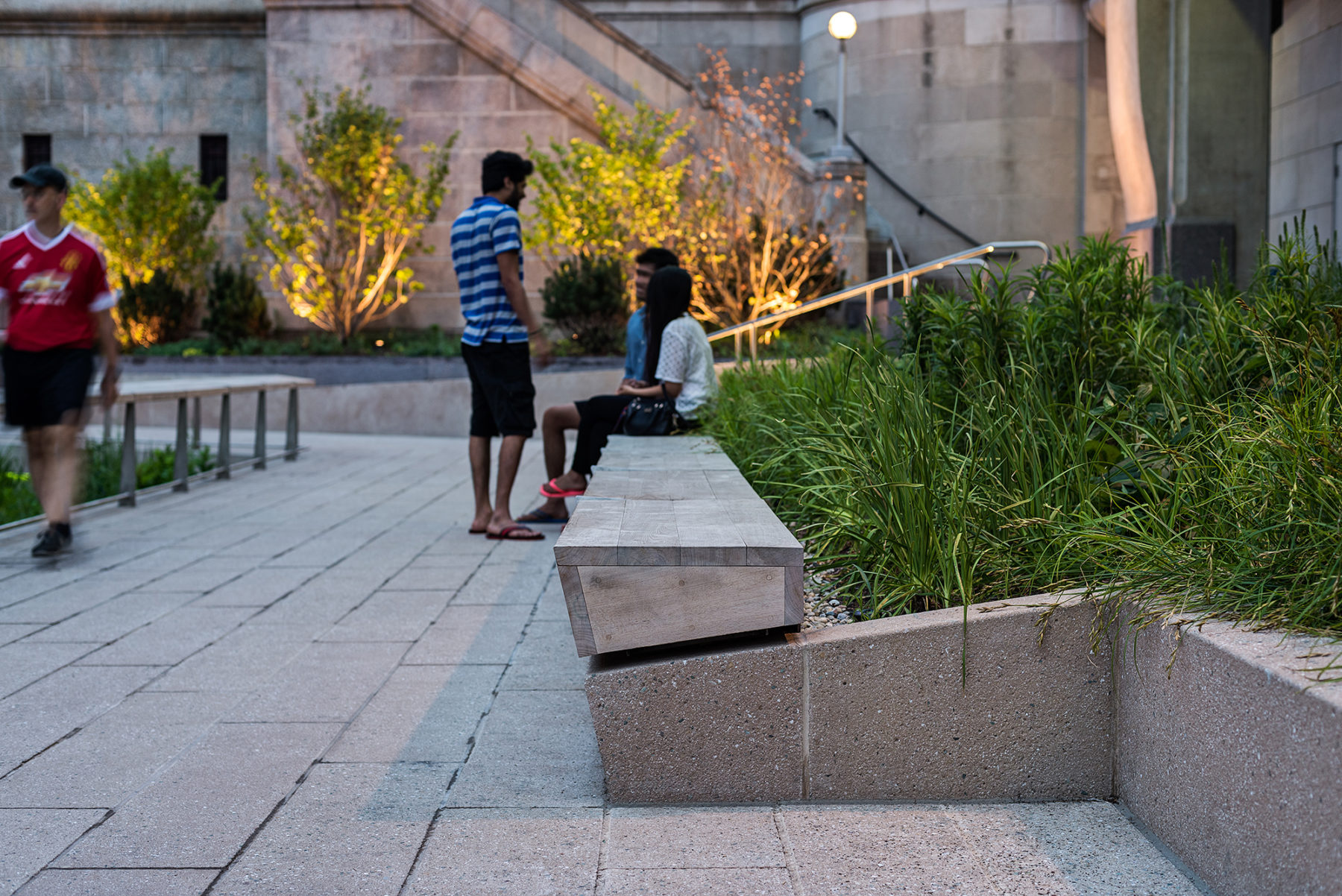
Custom seating in the Jetty
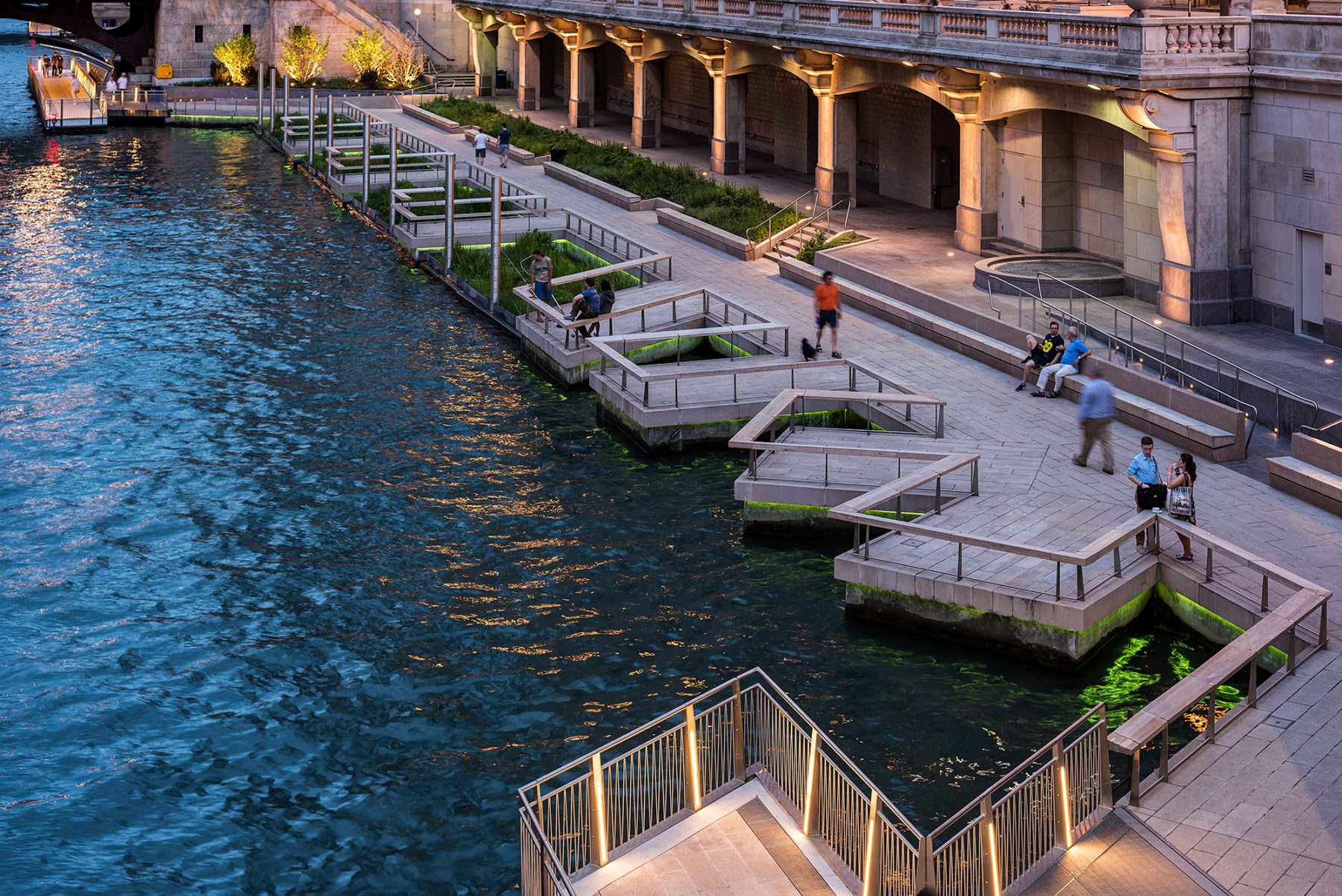
The Jetty embodies the philosophy that truly sustainable design accounts for the whole environment—not only for humans
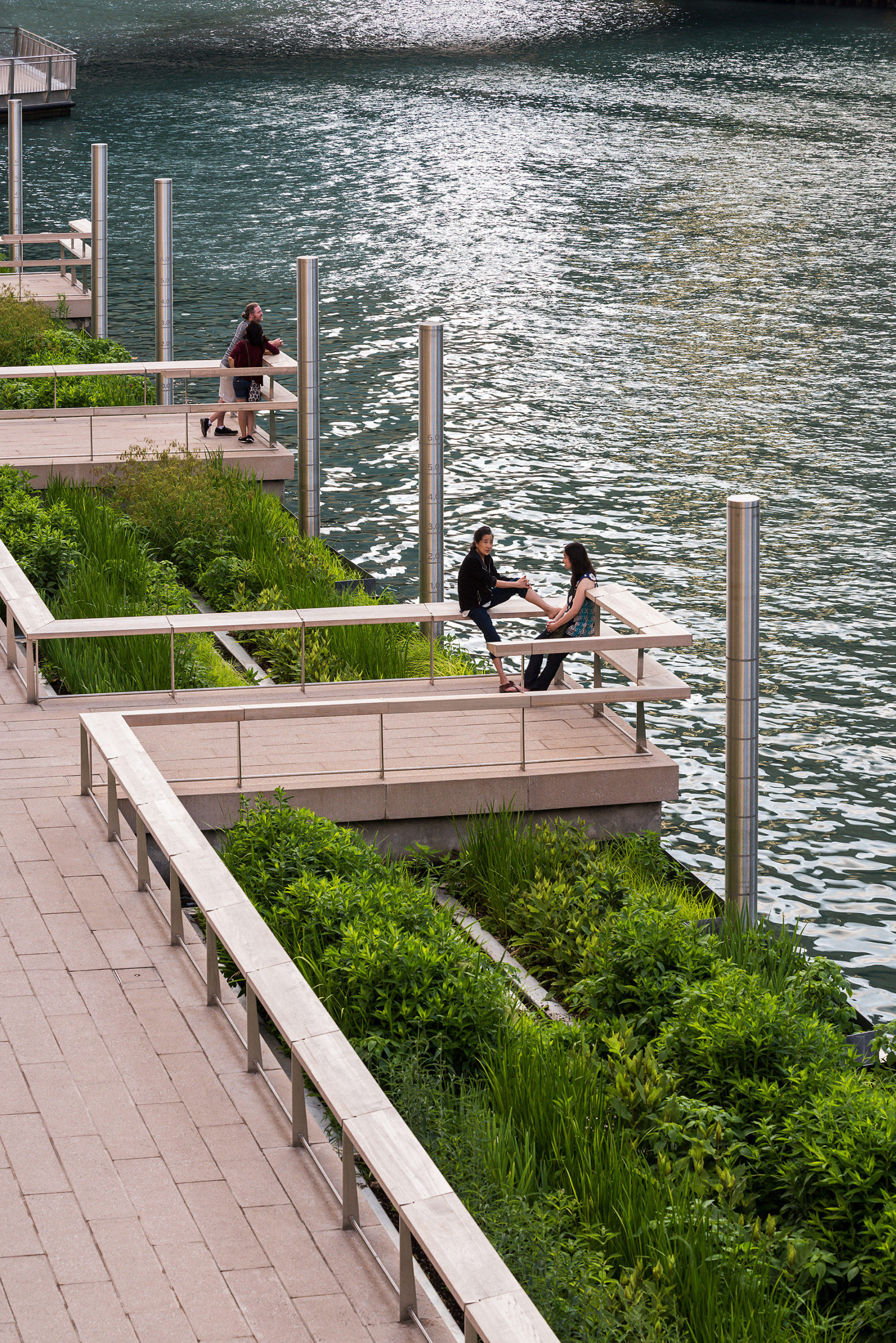
The floating wetlands are framed in stainless steel and then attached to the piers
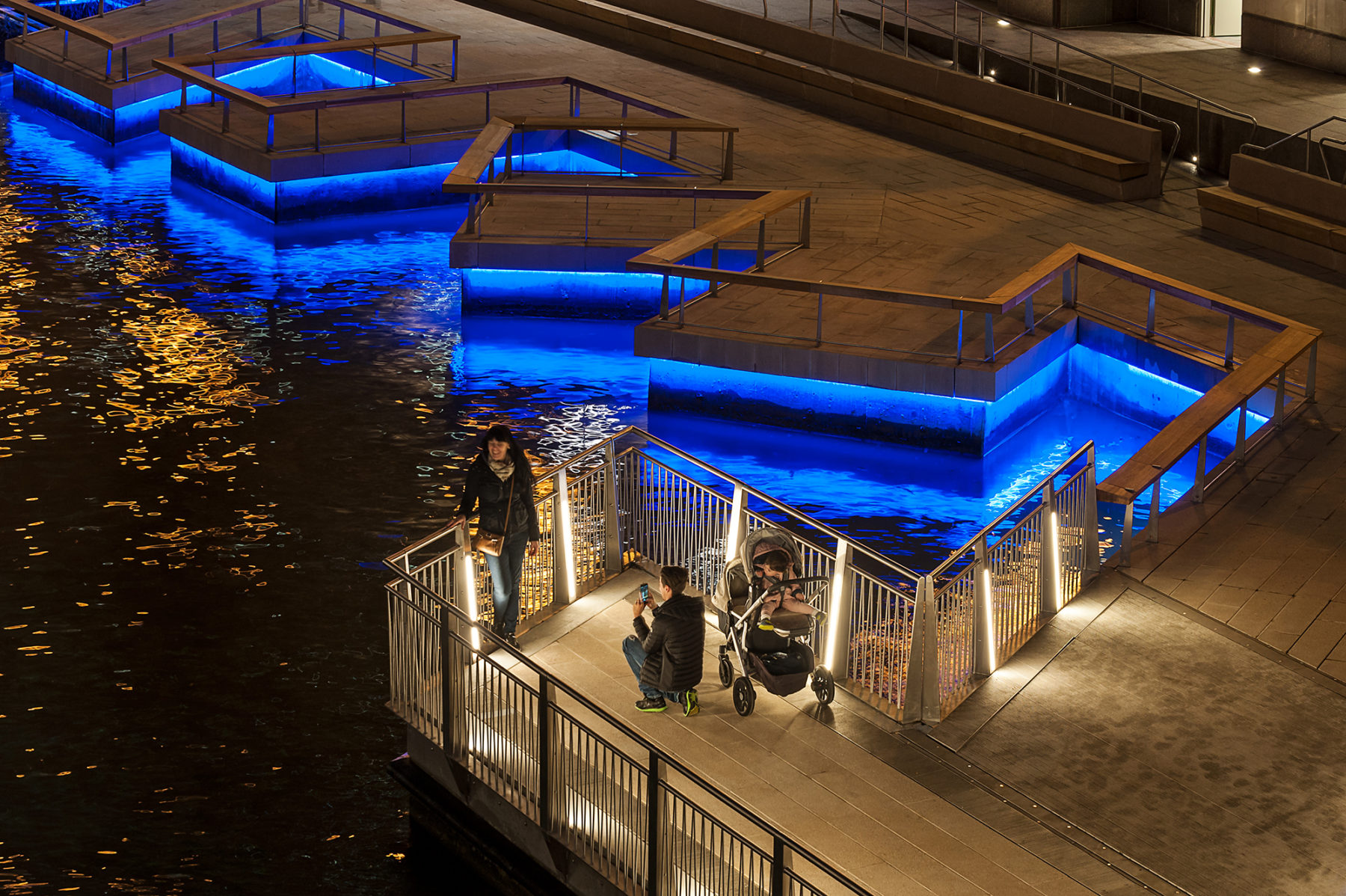
Boardwalk spaces, illuminated at night, intertwine with the constructed fish habitat, and provide places for pedestrians to observe, fish, and learn
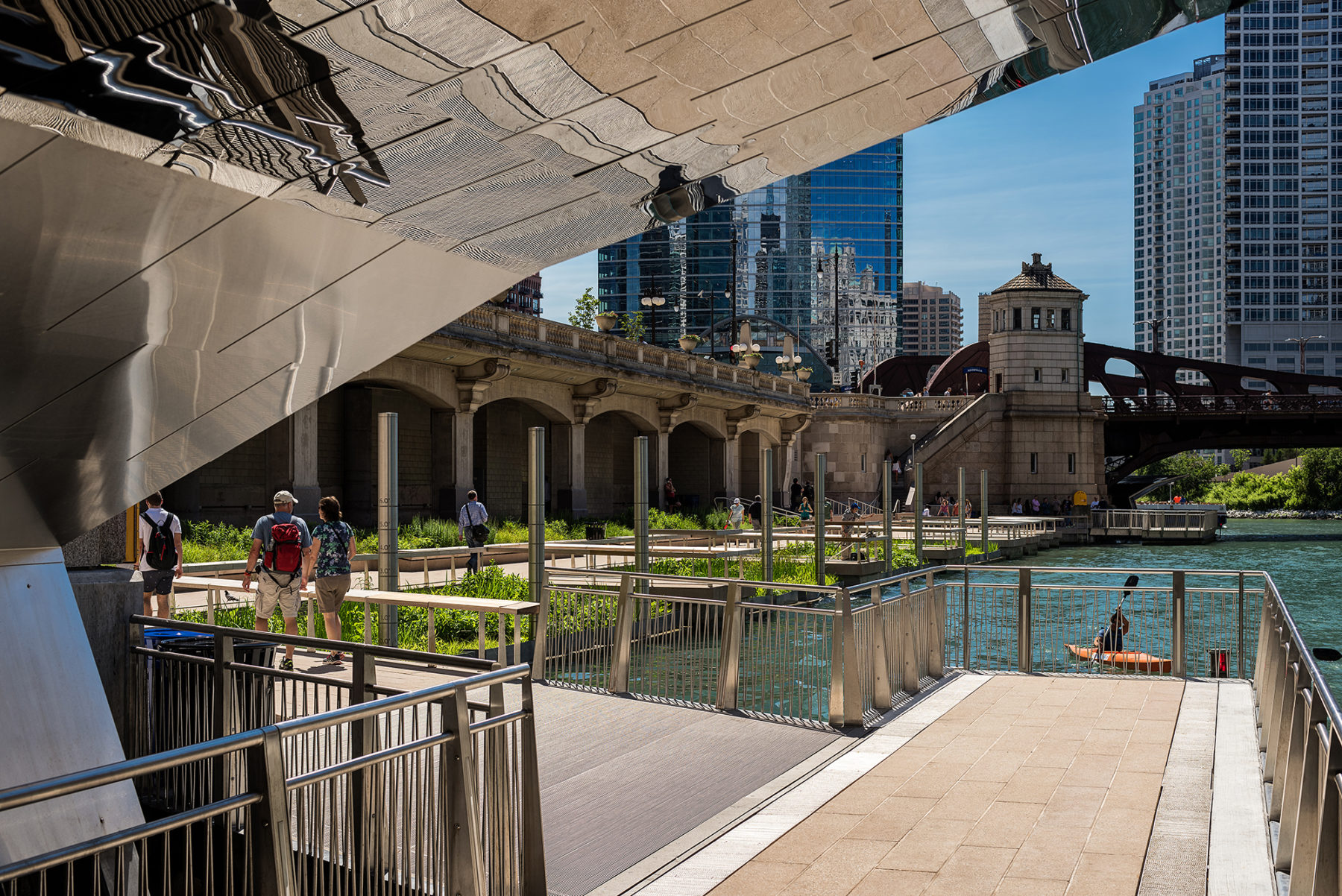
Underbridge connection from leading to the Jetty
A series of piers and floating wetland gardens offers an interactive learning environment about the ecology of the river, including opportunities for fishing and identifying native plants
The new connective spaces of the Riverwalk also act as critical linkages to existing open space systems in the city
The Jetty gets it name from the seven narrow piers, or jetties, that extend into the river
Accessible height railings ensure all are able to enjoy views of the river
The Jetty also incorporates several innovative and low-cost features—lunkers, curtains, and hulas—that will ensure a great experience for those species who live below the surface
Custom seating in the Jetty
The Jetty embodies the philosophy that truly sustainable design accounts for the whole environment—not only for humans
The floating wetlands are framed in stainless steel and then attached to the piers
Boardwalk spaces, illuminated at night, intertwine with the constructed fish habitat, and provide places for pedestrians to observe, fish, and learn
Underbridge connection from leading to the Jetty
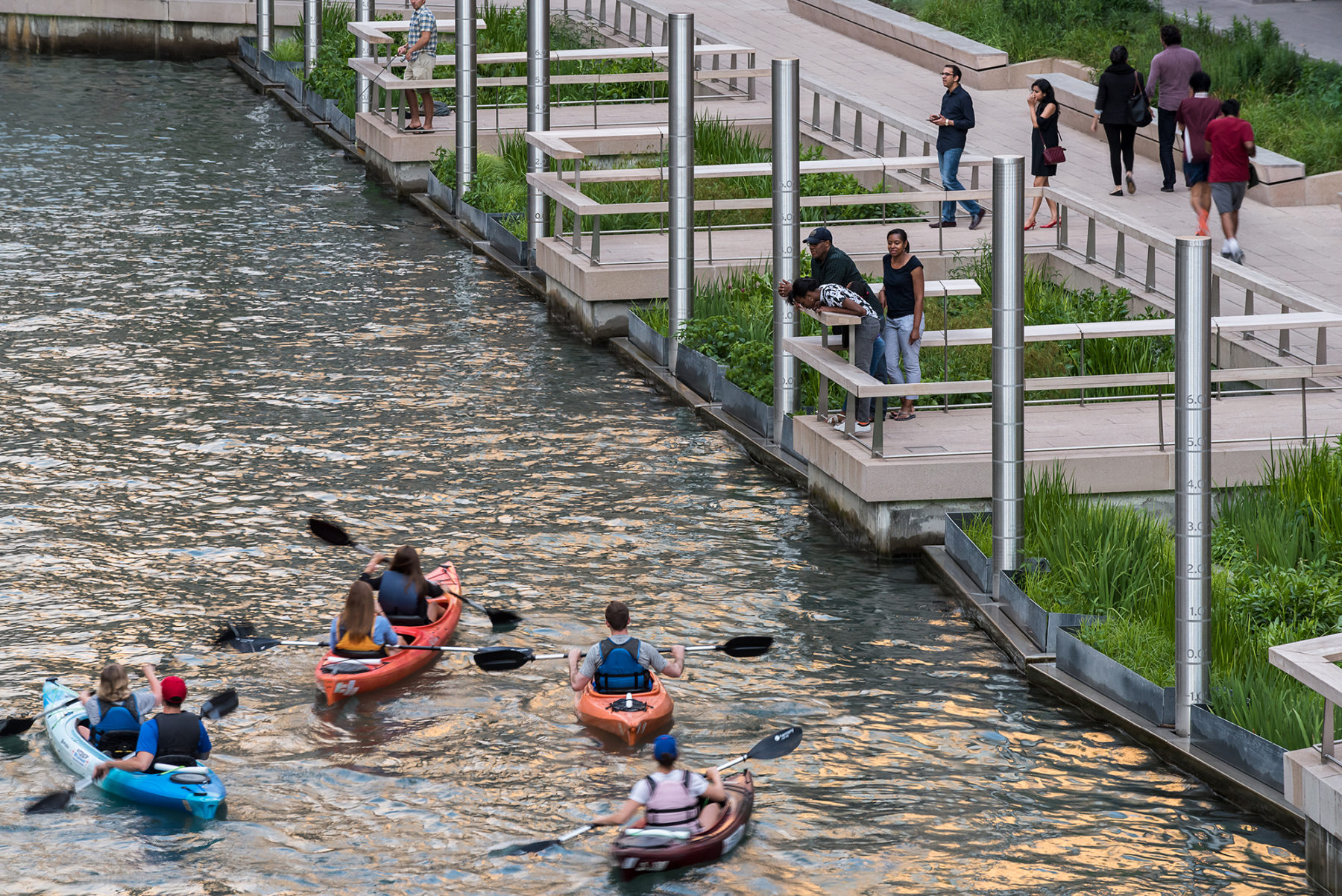
The realized project threads together the experience of the river’s edge and allows direct access to the water, welcoming those on foot and by boat and enabling the life of the city and life on the river to co-mingle
The Riverbank
An accessible walkway and new marine edge create continuous access to Lake Street and sets the scene for future development in this critical space at the confluence.
As a new connected path system, the Chicago Riverwalk design provides both continuity and variety for a park visitor. The distinct programs and forms of each typological space allow for diverse experiences on the river ranging from dining opportunities to expansive public event programming to new amenities for human-powered craft. At the same time, design materials, details, and repeated forms provide visual cohesion along the entire length of the project. Paving, for instance, mirrors the contrasts of the existing context: A refined cut stone follows the elegant Beaux-Arts Wacker viaduct and bridgehouse architecture, while a more rugged precast plank flanks the lower elevations and underside of the exposed steel bridges.
For more information contact Zachary Chrisco.

